#its wild seeing some of the more intense younger fans on twitter being intense about it the way i used to be abt things….
Explore tagged Tumblr posts
Text
ep 7 is just weird bc i dont think any of the Things that happened were out of character i just feel like a lot of the dialogue absolutely was
#like not just for ed and stede but everybody#maybe im wrong but idkkkkk#i know ‘oh thats ooc’ coming from a fan is always a biased topic but i never felt that way before#imma zip it about this subject now tho bc i dont want it to be one of those sticky ocd points for me#but i do still feel quite unfuckable about the whole thing#idc if myself and everybody else absolutely despised an episode baby aint nothing gonna break my stride anymore#its wild seeing some of the more intense younger fans on twitter being intense about it the way i used to be abt things….#like ships passing in the night…#i Get It but also the joy is more important 2 me now
7 notes
·
View notes
Text
Annette: The AD Devotee Review
So I saw Annette on its premiere night in Cannes and I’m still trying to process and make sense of those 2.5 hours of utter insanity. I have no idea where to begin and this is likely going to become an unholy length by the time I’m finished, so I apologize in advance. But BOY I’ve got a lot to parse through!!
Let’s start here: Adam’s made plenty of weird movies. The Dead Don’t Die? The Man Who Killed Don Quixote? There are definitely Terry Gilliam-esque elements of the unapologetically absurd and fantastical in Annette, but NOTHING comes close to this film. To put it bluntly, nothing I write in this post can prepare you for the eccentric phantasmagoria you’re about to sit through.
While the melodies conveying the story – at times lovely and haunting, at times whimsical, occasionally blunt and simple – add a unique sense of the surreal, the fact that it’s all presented in song somehow supplies the medium for this bizarre concoction of disparate elements and outlandish storytelling to all coalesce into a single genre-defying, disbelief-suspending whole. That’s certainly not to say there weren’t a few times when I quietly chortled to myself and mouthed “what the fuck” from behind my mask when things took an exceeding turn to the outrageous. This movie needs to be permitted a bit of leeway in terms of quality judgments, and traditional indicators certainly won’t apply. I would say part of its appeal (and ultimately its success) stems from its lack of interest in appealing to traditional arbiters of film structure and viewing experience. The movie lingers in studies of discomfiture (I’ll return to this theme); it presents all its absurdities with brazen pride rather than temperance; and its end is abrupt and utterly jarring. Yet somehow, at the end of it, I realized I’d been white-knuckling that rollercoaster ride the whole way through and loved every last twist and turn.
A note on the structure of this post before I dive in: I’ve written out a synopsis of the whole film (for those spoiler-hungry people) and stashed it down at the bottom of this post, so no one trying to avoid spoilers has to scroll through. If you want to read, go ahead and skip down to that before reading the discussion/analysis. If I have to reference a specific plot point, I’ll label it “Spoiler #___” and those who don’t mind being spoiled can check the correlating numbers in my synopsis to see which part I’m referencing. Otherwise, my discussion will be spoiler-free! I do detail certain individual scenes, but hid anything that would give away key developments and/or the ending.
To start, I’ll cut to what I’m sure many of you are here for: THE MUSICAL SEX SCENES. You want detailed descriptions? Well let’s fucking go because these scenes have been living in my head rent-free!!
The first (yes, there are two. Idk whether to thank Mr. Carax or suggest he get his sanity checked??) happens towards the end of “We Love Each Other So Much.” Henry carries Ann to the bed with her feet dangling several inches off the floor while she has her arms wrapped around his shoulders. (I maybe whimpered a tiny bit.) As they continue to sing, you first see Ann spread on her back on the bed, panting a little BUT STILL SINGING while Henry’s head is down between her thighs. The camera angle is from above Ann’s head, so you can clearly see down her body and exactly what’s going on. He lifts his head to croon a line, then puts his mouth right back to work.
And THEN they fuck – still fucking singing! They’re on their sides with Henry behind her, and yes there is visible thrusting. Yes, the thrusting definitely picks up speed and force as the song reaches its crescendo. Yes, it was indeed EXTREMELY sensual once you got over the initial shock of what you’re watching. Ann kept her breasts covered with her own hands while Henry went down on her, but now his hands are covering them and kneading while they’re fucking and just….. It’s a hard, blazing hot R rating. I also remember his giant hand coming up to turn her head so he can kiss her and ladkjfaskfjlskfj. Bring your smelling salts. I don’t recommend sitting between two older ladies while you’re watching – KINDA RUINED THE BLATANT, SMOKING HOT ADAM PORN FOR ME. Good god, choose your viewing buddy wisely!
The second scene comes sort of out of nowhere – I can’t actually recall which song it was during, but it pops up while Ann is pregnant. Henry is again eating her out and there’s not as much overt singing this time, but he has his giant hands splayed over her pregnant belly while he’s going to town and whew, WHEW TURN ON THE AIR CONDITIONING PLEASE. DID THE THEATER INCREASE IN TEMPERATURE BY 10 DEGREES, YOU’RE DAMN RIGHT IT DID.
Whew. I think you’ll be better primed to ~enjoy~ those scenes when you know they’re coming, otherwise it’s just so shocking that by the time you’ve processed “Look at Adam eating pussy with reckless abandon” it’s halfway over already. God speed, my fellow rats, it’s truly something to witness!!
Okay. Right. Ahem. Moving right on along….
I’ll kick off this discussion with the formal structure of the film. It’s honestly impossible to classify. I have the questionable fortune of having been taken to many a strange avant-garde operas and art exhibitions by my parents when I was younger, and the strongest parallel I found to this movie was melodramatic opera stagings full of flamboyant flourishes, austere set pieces, and prolonged numbers where the characters wallow at length in their respective miseries. This movie has all the elevated drama, spectacle, and self-aggrandizement belonging to any self-professed rock opera. Think psychedelic rock opera films a la The Who’s Tommy, Hair, Phantom of the Paradise, and hell, even Rocky Horror. Yes, this film really is THAT weird.
But Annette is also in large part a vibrant, absurdist performance piece. The film is intriguingly book-ended by two scenes where the lines blur between actor and character; and your own role blurs between passive viewer and interactive audience. The first scene has the cast walking through the streets of LA (I think?), singing “So May We Start?” directly to the camera in a self-aware prologue, smashing the fourth wall from the beginning and setting up the audience to play a direct role in the viewing experience. Though the cast then disburse and take up their respective roles, the sense of being directly performed to is reinforced throughout the film. This continues most concretely through Henry’s multiple stand-up comedy performances.
Though he performs to an audience in the film rather than directly to live viewers, these scenes are so lengthy, vulgar, and excessive that his solo performance act becomes an integral part of defining his character and conveying his arc as the film progresses. These scenes start to make the film itself feel like a one-man show. The whole shtick of Henry McHenry’s “Ape of God” show is its perverse irreverence and swaggering machismo. Over the span of what must be a five minute plus scene, Henry hacks up phlegm, pretends to choke himself with his microphone cord, prances across the stage with his bathrobe flapping about, simulates being shot, sprinkles many a misanthropic, charmless monologues in between, and ends by throwing off his robe and mooning the audience before he leaves the stage. (Yes, you see Adam’s ass within the film’s first twenty minutes, and we’re just warming up from there.) His one-man performances demonstrate his egocentrism, penchant for lowbrow and often offensive humor, and the fact that this character has thus far profited from indulging in and acting out his base vulgarities.
While never demonstrating any abundance of good taste, his shows teeter firmly towards the grotesque and unsanctionable as his marriage and mental health deteriorate. This is what I’m referring to when I described the film as a study in discomfiture. As he deteriorates, the later iterations of his stand-up show become utterly unsettling and at times revolting. The film could show mercy and stop at one to two minutes of his more deranged antics, but instead subjects you to a protracted display of just how insane this man might possibly be. In Adam’s hands, these excessive, indulgent performance scenes take on disturbing but intriguing ambiguity, as you again wonder where the performance ends and the real man begins. When Henry confesses to a crime during his show and launces into an elaborate, passionate reenactment on stage, you shift uncomfortably in your seat wondering how much of it might just be true. Wondering just how much of an animal this man truly is.
Watching this film as an Adam fan, these scenes are unparalleled displays of his range and prowess. He’s in turns amusing and revolting; intolerable and pathetic; but always, always riveting. I couldn’t help thinking to myself that for the casual, non Adam-obsessed viewer, the effect of these scenes might stop at crass and unappealing. But in terms of the sheer range and power of acting on display? These scenes are a damn marvel. Through these scenes alone, his performance largely imbues the film with its wild, primal, and vaguely menacing atmosphere.
His stand-up scenes were, to me, some of the most intense of the film – sometimes downright difficult to endure. But they’re only a microcosm of the R A N G E he exhibits throughout the film’s entirety. Let’s talk about how he’s animalistic, menacing, and genuinely unsettling to watch (Leos Carax described him as “feline” at some point, and I 100% see it); and then with a mere subtle twitch of his expression, sheen of his eyes, or slump of his shoulders, he’s suddenly a lost, broken thing.
Henry McHenry is truly to be reviled. Twitter might as well spare their breath and announce he’s already cancelled. He towers above the rest of the cast with intimidating, predatory physicality; he is prone to indulgence in his vices; and he constantly seems at risk of releasing some wild, uncontrollable madness lingering just beneath his surface. But as we all well know, Adam has an unerring talent for lending pathos to even the most objectively condemnable characters.
In a repeated refrain during his first comedy show, the audience keeps asking him, “Why did you become a comedian?” He dodges the question or gives sarcastic answers, until finally circling back to the true answer later in the film. It was something to the effect of: “To disarm people. It’s the only way I can tell the truth without it killing me.” Even for all their sick spectacle, there are also moments in his stand-up shows of disarming vulnerability and (seeming) honesty. In a similar moment of personal exposition, he confesses his temptation and “sympathy for the abyss.” (This phrase is hands down my favorite of the film.) He repeatedly refers to his struggle against “the abyss” and, at the same time, his perceived helplessness against it. “There’s so little I can do, there’s so little I can do,” he sings repeatedly throughout the film - usually just after doing something horrific.
Had he been played by anyone else, the first full look of him warming up before his show - hopping in place and punching the air like some wannabe boxer, interspersing puffs of his cigarette with chowing down on a banana – would have been enough for me to swear him off. His archetype is something of a cliché at this point – a brusque, boorish man who can’t stomach or preserve the love of others due to his own self-loathing. There were multiple points when it was only Adam’s face beneath the character that kept my heart cracked open to him. But sure enough, he wedged his fingers into that tiny crack and pried it wide open. The film’s final few scenes show him at his chin-wobbling best as he crumbles apart in small, mournful subtleties.
(General, semi-spoiler ahead as to the tone of the film’s ending – skip this paragraph if you’d rather avoid.) For a film that professes not to take itself very seriously (how else am I supposed to interpret the freaky puppet baby?), it delivers a harsh, unforgiving ending to its main character. And sure enough, despite how much I might have wanted to distance myself and believe it was only what he deserved, I found myself right there with him, sharing his pain. It is solely testament to Adam’s tireless dedication to breathing both gritty realism and stubborn beauty into his characters that Henry sank a hook into some piece of my sympathy.
Not only does Adam have to be the only actor capable of imbuing Henry with humanity despite his manifold wrongs, he also has to be the only actor capable of the wide-ranging transformations demanded of the role. He starts the movie with long hair and his full refrigerator brick house physique. His physicality and size are actively leveraged to engender a sense of disquiet and unpredictability through his presence. He appears in turns tormented and tormentor. There were moments when I found myself thinking of Conan the Barbarian, simply because his physical presence radiates such wild, primal energy (especially next to tiny, dainty Marion and especially with that long hair). Cannot emphasize enough: The raw sex appeal is off the goddamn charts and had me – a veteran fangirl of 3+ years - shook to my damn core.
The film’s progression then ages him – his hair cut shorter and his face and physique gradually becoming more gaunt. By the film’s end, he has facial prosthetics to make him seem even more stark and borderline sickly – a mirror of his growing internal torment. From a muscular, swaggering powerhouse, he pales and shrinks to a shell of a man, unraveling as his face becomes nearly deformed by time and guilt. He is in turns beautiful and grotesque; sensual and repulsive. I know of no other actor whose face (and its accompanying capacity for expressiveness) could lend itself to such stunning versatility.
Quick note here that he was given a reddish-brown birthmark on the right side of his face for this film?? It becomes more prominent once his hair is shorter in the film’s second half. I’m guessing it was Leos’ idea to make his face even more distinctive and riveting? If so, joke’s on you, Mr. Carax, because we’re always riveted. ☺
I mentioned way up at the beginning that the film is bookended by two scenes where the lines blur between actor and character, and between reality and performance. This comes full circle at the film’s end, with Henry’s final spoken words (this doesn’t give any plot away but skip to the next paragraph if you would rather avoid!) being “Stop watching me.” That’s it. The show is over. He has told his last joke, played out his final act, and now he’s done living his life as a source of cheap, unprincipled laughs and thrills for spectators. The curtain closes with a resounding silence.
Now, I definitely won’t have a section where I talk (of course) about the Ben Solo parallels. He’s haunted by an “abyss” aka darkness inside of him? Bad things happened when he finally gave in and stared into that darkness he knew lived within him? As a result of those tragedies, (SPOILER – Skip to next paragraph to avoid) he then finds himself alone and with no one to love or be loved by? NO I’M DEFINITELY NOT GOING TO TALK ABOUT IT AT ALL, I’M JUST FINE HERE UNDER MY MOUNTAINS OF TISSUES.
Let’s talk about the music! The film definitely clocks in closer to a rock opera than musical, because almost the entire thing is conveyed through ongoing song, rather than self-contained musical numbers appearing here and there. This actually helps the film’s continuity and pacing, by keeping the characters perpetually in this suspended state of absurdity, always propelled along by some beat or melody. Whenever the film seems on the precipice of tipping all the way into the bleak and dark, the next whimsical tune kicks in to reel us all blessedly back. For example, after (SPOILER #1) happens, there’s a hard cut to the bright police station where several officers gather around Henry, bopping about and chattering on the beat “Questions! We have a few questions!”
Adam integrates his singing into his performance in such a way that it seems organic. I realized after the film that I never consciously considered the quality of his singing along the way. For all that I talked about the film maintaining the atmosphere of a fourth wall-defying performance piece, Adam’s singing is so fully immersed in the embodiment of his character that you almost forget he’s singing. Rather, this is simply how Henry McHenry exists. His stand-up scenes are the only ones in the film that do frequently transition back and forth between speaking and singing, but it’s seamlessly par for the course in Henry’s bizarre, dour show. He breaks into his standard “Now laugh!” number with uninterrupted sarcasm and contempt. There were certainly a few soft, poignant moments when his voice warbled in a tender vibrato you couldn’t help noticing – but otherwise, the singing was simply an extension of that full-body persona he manages to convey with such apparent ease and naturalism.
On the music itself: I’ll admit that the brief clip of “We Love Each Other So Much” we got a few weeks ago made me a tad nervous. It seemed so cheesy and ridiculous? But okay, you really can’t take anything from this movie out of context. Otherwise it is, indeed, utterly ridiculous. Not that none of it is ever ridiculous in context either, but I’m giving you assurances right now that it WORKS. Once you’re in the flow of constant singing and weirdness abound, the songs sweep you right along. Some of the songs lack a distinctive hook or melody and are moreso rhythmic vehicles for storytelling, but it’s now a day later and I still have three of the songs circulating pleasantly in my head. “We Love Each Other So Much” was actually the stand out for me and is now my favorite of the soundtrack. It’s reprised a few times later in the film, growing increasingly melancholy each time it is echoed, and it hits your heart a bit harder each time. The final song sung during (SPOILER #2), though without a distinctive melody to lodge in my head, undoubtedly left me far more moved than a spoken version of this scene would have. Adam’s singing is so painfully desperate and earnest here, and he takes the medium fully under his command.
Finally, it does have to be said that parts of this film veer fully towards the ridiculous and laughable. The initial baby version of the Annette puppet-doll was nothing short of horrifying to me. Annette gets more center-stage screen time in the film’s second half, which gives itself over to a few special effects sequences which look to be flying out at you straight from 2000 Windows Movie Maker. The scariest part is that it all seems intentional. The quality special effects appear when necessary (along with some unusual and captivating time lapse shots), which means the film’s most outrageous moments are fully in line with its guiding spirit. Its extravagant self-indulgence nearly borders on camp.
...And with that, I’ve covered the majority of the frantic notes I took for further reflection immediately after viewing. It’s now been a few days, and I’m looking forward to rewatching this movie when I can hopefully take it in a bit more fully. This time, I won’t just be struggling to keep up with the madness on screen. My concluding thoughts at this point: Is it my favorite Adam movie? Certainly not. Is it the most unforgettable? Aside from my holy text, The Last Jedi, likely yes. It really is the sort of thing you have to see twice to even believe it. And all in all, I say again that Adam truly carried this movie, and he fully inhabits even its highest, most ludicrous aspirations. He’s downright abhorrent in this film, and that’s exactly what makes him such a fucking legend.
I plan to make a separate post in the coming days about my experience at Cannes and the Annette red carpet, since a few people have asked! I can’t even express how damn good it feels to be globetrotting for Adam-related experiences again. <3

Thanks so much for reading! Feel free to ask me any further questions at all here or on Twitter! :)
*SYNOPSIS INCLUDED BELOW. DO NOT READ FURTHER IF AVOIDING SPOILERS!*
Synopsis: Comedian Henry McHenry and opera singer Ann Defrasnoux are both at the pinnacle of their respective success when they fall in love and marry. The marriage is happy and passionate for a time, leading to the birth of their (puppet) daughter, Annette. But tabloids and much of the world believe the crude, brutish Henry is a poor match for refined, idolized Ann. Ann and Henry themselves both begin to feel that something is amiss – Henry gradually losing his touch for his comedy craft, claiming that being in love is making him ill. He repeatedly and sardonically references how Ann’s opera career involves her “singing and dying” every night, to the point that he sees visions of her “dead” body on the stage. Meanwhile, Ann has a nightmare of multiple women accusing Henry of abusive and violent behavior towards them, and she begins growing wary in his presence. (He never acts abusively towards her, unless you count that scene when he tickles her feet and licks her toes while she’s telling him to stop??? Yeah I know, WILD.)
The growing sense of unease, that they’re both teetering on the brink of disaster, culminates in the most deranged of Henry’s stand-up comedy performances, when he gives a vivid reenactment of killing his wife by “tickling her to death.” The performance is so maudlin and unsettling that you wonder whether he’s not making it up at all, and the audience strongly rebukes him. (This is the “What is your problem?!” scene with tiddies out. The full version includes Adam storming across the stage, furiously singing/yelling, “What the FUCK is your problem?!”) But when Henry arrives home that night, drunk and raucous, Ann and Annette are both unharmed.
The couple take a trip on their boat, bringing Annette with them. The boat gets caught in a storm, and Henry drunkenly insists that he and Ann waltz in the storm. She protests that it’s too dangerous and begs him to see sense. (SPOILER #1) The boat lurches when Henry spins her, and Ann falls overboard to her death. Henry rescues Annette from the sinking boat and rows them both to shore. He promptly falls unconscious, and a ghost of Ann appears, proclaiming her intention to haunt Henry through Annette. Annette (still a toddler at this point and yes, still a wooden puppet) then develops a miraculous gift for singing, and Henry decides to take her on tour with performances around the world. He enlists the help of his “conductor friend,” who had been Ann’s accompanist and secretly had an affair with her before she met Henry.
Henry slides further into drunken debauchery as the tour progresses, while the Conductor looks after Annette and the two grow close. Once the tour concludes, the Conductor suggests to Henry that Annette might be his own daughter – revealing his prior affair with Ann. Terrified by the idea of anyone finding out and the possibility of losing his daughter, Henry drowns the Conductor in the pool behind his and Ann’s house. Annette sees the whole thing happen from her bedroom window.
Henry plans one last show for Annette, to be held in a massive stadium at the equivalent of the Super Bowl. But when Annette takes the stage, she refuses to sing. Instead, she speaks and accuses Henry of murder. (“Daddy kills people,” are the actual words – not that that was creepy to hear as this puppet’s first spoken words or anything.)
Henry stands trial, during which he sees an apparition of Ann from when they first met. They sing their regret that they can’t return to the happiness they once shared, until the apparition is replaced by Ann’s vengeful spirit, who promises to haunt Henry in prison. After his sentencing (it’s not clear what the sentence was, but Henry definitely isn’t going free), Annette is brought to see him once in prison. Speaking fully for the first time, she declares she can’t forgive her parents for using her: Henry for exploiting her voice for profit and Ann for presumably using her to take vengeance on Henry. (Yes, this is why she was an inanimate doll moving on strings up to this point – there was some meaning in that strange, strange artistic choice. She was the puppet of her parents’ respective egotisms.) The puppet of Annette is abruptly replaced by a real girl in this scene, finally enabling two-sided interaction and a long-missed genuine connection between her and Henry, which made this quite the emotional catharsis. (SPOILER #2) It concludes with Annette still unwilling to forgive or forget what her parents have done, and swearing never to sing again. She says Henry now has “no one to love.” He appeals, “Can’t I love you, Annette?” She replies, “No, not really.” Henry embraces her one last time before a guard takes her away and Henry is left alone.
…..Yes, that is the end. It left me with major emotional whiplash, after the whole film up to this point kept pulling itself back from the total bleak and dark by starting up a new toe-tapping, mildly silly tune every few minutes. But this last scene instead ends on a brutal note of harsh, unforgiving silence.
BUT! Make sure you stick around through the credits, when you see the cast walking through a forest together. (This is counterpart to the film’s opening, when you see the cast walking through LA singing “So May We Start?” directly to the audience) Definitely pay attention to catch Adam chasing/playing with the little girl actress who plays Annette! That imparts a much nicer feeling to leave the theater with. :’)
112 notes
·
View notes
Text
The True Mighty Bison - Season V edition.
Some weeks ago, I had a very productive discussion on twitter with Steven Mane about the subject of this essay, and he brought up very good points, an alternative theory (not as out there as mine) and reminded me I haven't actually added the ACTUAL Seth info from his story and Arcade endings to this text. Now that even Rose is on the game (although she didn't bring new info on this front), Let's update this very wild theory about our favorite psycho powered dictator. For the day you discovered the truth about M. Bison was the most important of your Street Fighter fan life. But for them, it was only Tuesday. HEAVY SPOILERS FOR SETH'S SFV STORY MODE AND ENDING. and in a lesser intensity, Rose's. -----------------------------------------------------------------------------
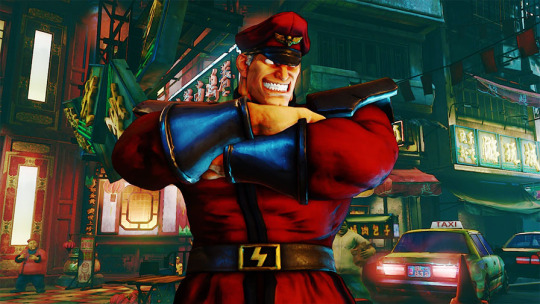
This is M. Bison. Bison is one first class A-hole who runs the biggest crime syndicate on the world (Shadaloo), wants to spark global destruction if not given global domination and has a tendency to kidnap 16 year old girls. Bison also wields something called Psycho Power. Through profane rituals (more of this in a bit), He is the biggest source/receptacle of it. this power is also destroying his body, which leads to the only thing he likes more than kidnapping 16 year old girls: Body Swapping. The body in the picture is not his original body, not even his first, but is the... model we are most used to see him using. This is how you would imagine him if one mentioned M. Bison. In SFV he finally got grey/white hair, but originally this body had black hair.

however...
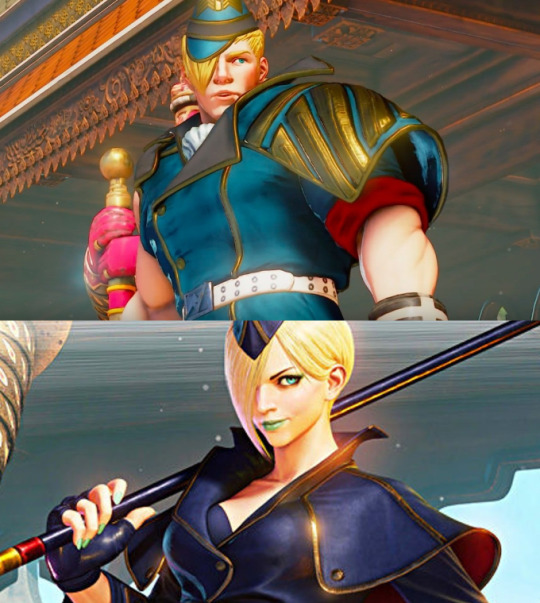
These are Ed and Falke. They are CLONED Bodies of Bison, They are both spare bodies for M. Bison, created in a attempt to build a body strong enough to hold his power. They are both of the most recent attempt, the newer models so to speak. As far as we know, they are all biological (a point that will come up later) and since CAPCOM use the word CLONES, they share the same DNA as Bison. Physically speaking, they are around their late teens, although being much younger actually (both suffered from accelerated aging). They escaped Shadaloo due to the fact that an older model ended up destroying the base where they were being held. speaking of the Devil....
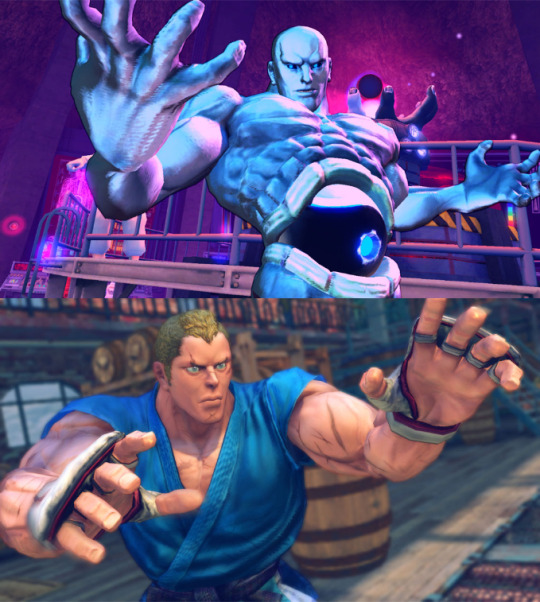
These are Seth and Abel. Also, spare bodies of Bison. But (un)fortunately, they developed a conscience and independence. While Abel ran away and joined the french army, Seth created a splinter cell from Shadaloo called S.I.N. and planned a hostile takeover of the syndicate. One interesting fact is that both Seth and Abel are the SAME MODEL of bodies, but Seth installed the upgrade of the Tanden Engine on his body. So Seth was once like Abel and if given enough time and the proper modifications, Abel could become like Seth. One recent release on Street Fighter V revealed the Seth was always more machine than man. If that is plainly due the Tanden Engine modification and what this means to Abel, its still unknown. both (Abel more than Seth) still have Bison’s DNA on them. Also, Bison considers this batch of clones a FAILED experiment Seth was the final Boss of Street Fighter IV, and Abel was the protagonist of that series. but, the older models are the more interesting ones.
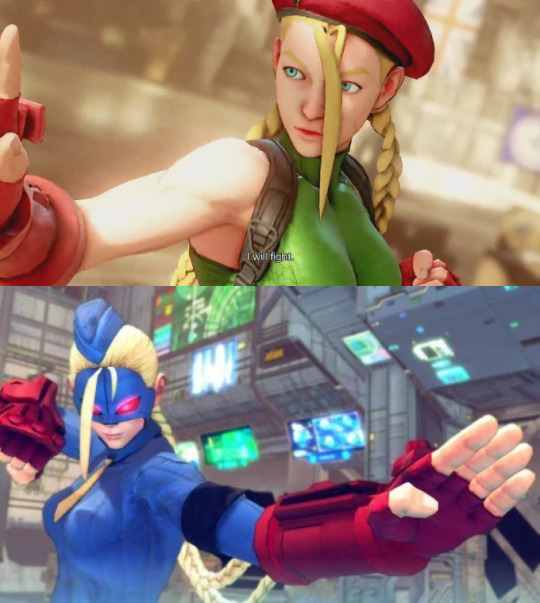
These are Cammy and Decapre. Both are the oldest clone models player knew until recently. They are also fully biological and the first successful vessels for Psycho Power. Decapre is actually a “ Cammy Alpha“, a first attempt to create Cammy herself. Being fully biological, they ALSO carry Bison’s DNA. While Cammy became independent and joined the British Army, Decapre stayed brainwashed and a weapon for Shadaloo until recently (SFIV). Both Decapre and Cammy were part of a shadaloo project call “The Dolls project“: Most of the Dolls were the kidnapped teenage girls mentioned before, who were also test beds for Bison’s mind control via psycho power. There were 12 Dolls (Decapre and other 11), with Cammy being a 13th, codenamed Killer Bee. As of now, you probably noticed: 3 males, 3 females. We might be onto something here. But remember that profane ritual I mentioned? One of the results was this lady here...
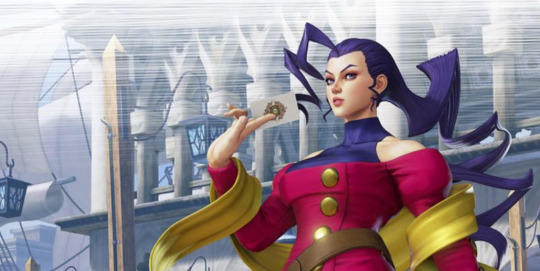
This is Rose. In order to get full access to Psycho Power, Bison had to EXPEL ALL THE GOOD ENERGY FROM HIS SOUL. No joking. the good half of Bison’s Soul incarnated on a young Italian GIRL who was being born that moment and who grew up to be a incredible psychic and fortune teller ,plus the most powerful user of the SOUL POWER, the opposite to Bison’s Psycho Power. so Rose is the REINCARNATION of Bison’s soul, or at least half of it. After the events of SF Alpha 3, Bison even used Rose’s body as a vessel, to hide himself from the authorities. How she was freed and what happened to her during SFII is still unknown. Street Fighter V didn't really expanded on the relationship between Rose and Bison, as much as confirmed that as of the end of A Shadow Falls (SFV general story mode), Bison's is truly gone, at least as definitive as Rose can sense. Let's also remember that, until the interference of Rose herself, Cammy/Killer Bee was considered a succesfull attempt at creating the perfect body. If Rose hadn't freed Cammy's mind, which was as close to a blank slate and receptive as possible, its highly probable that Bison would be using her body instead. Still with me? STREET FIGHTER V: ARCADE EDITION added another point on this list: SETH was released in 2020 as a playable character, part of Season IV. HOWEVER, the FORM he appeared is quite the surprise.

THIS IS SETH! YES, THAT SAME SETH!! (a name tag on SFV confirms this is number 15, the seth that was at the center of SFIV events) After having all of his bodies destroyed during SFIV, his brain was placed by Juri on an old body known as DOLL UNIT 0. The interesting thing here is that Jury is doing this in behalf of a third party, identified only as voice on phone. This voice expected a male body, while Juri didn't even noticed (or cared) that Seth or DU0's had a gender. Doll Unit 0's body accepted Seth's biological brain without a problem. Seth's mind however, is on turmoil. When integrating with the DU0' original personality, something went wrong and Seth went completely batshit crazy. He only sees Psycho Power, and mistook Ed and Falke as being Bison himself, due to their Psycho Power energy. Some lines, such as this Seth is true perfection hints on a ongoing attempt of accepting the new body. The Arcade mode ending and an extra Seth on his Critical Art during his V-trigger 1 also hints that Seth's true power lies in the INTEGRATION with this new body. ALL OF THESE, ALL OF IT, are just canon facts from the SF series lore. now for the speculation. Bison is not using the original body. And psycho power, specially the levels Bison desires, requires quite the strong one, which factors on why his current body is failing these days. why he had to abandon his original body? My only guess is that the profane ritual either destroyed it in the process or damaged it beyond repair. but at this point, Bison already had gained the power to posses other bodies. Doll Unit 0, the prototype for the perfect vessel, is female. Bison’s soul incarnated on a female body and until very recently, when his clone technology developed enough to create more radical deviations, the clones were all female. While there is several attempts of male bodies they are a late development and not only there is only one almost successful male body, it is the one that requires constant replacing AND Bison is trying to upgrade from, because it's not enough. But, the creation of a male body is stiil on the table and being attempted. Considering CAPCOM’s own words, that Seth is more machine than man, we can guess that Abel is probably just the biological basis for Seth, who is mostly the Tanden Engine and a biological brain. This is what was implemented into Doll Unit 0, who was completely female at that point, maybe even fully biological since Cammy, the earliest successful clone so far is fully biological as well. If we compare to real world cloning technology, cloning someone of the same gender is easier and more direct than altering the gender. Then there is the not-satated-but-extremely-obvious-fact that DU0 was the true first attempt at the tech that would produce Cammy, meaning, Shadaloo’s cloning tech was tested with HER. This also means that Doll Unit 0 IS EXTREMELY SIMILAR, IF NOT IDENTICAL, TO BISON'S ORIGINAL BODY. in conclusion: Bison’s original body is FEMALE and something close to this:
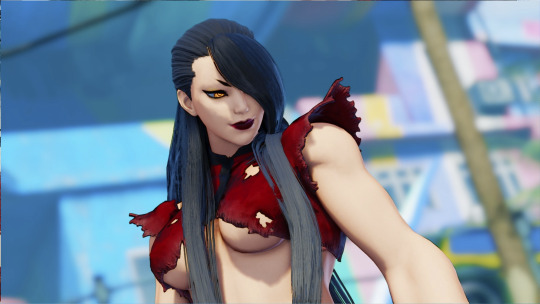
Thanks BbbSFXT from Deviant Art for the Mod and the picture. On the last version, I considered Mistress Bison being blonde, but thinking it through, it was more wishful thinking, trying to make them close to Cammy. Clones being a blonde is probably a side effect of DNA manipulation. Blond hair is recessive, and putting on the simplest, almost insulting way possible, it means blonde only happens if both sides of the DNA have the same code for hair. Since Bison is using the same DNA over and over, it makes sense clones would end up blonde. This also fits with DU0 being a very early prototype, with almost Bison's entire DNA intact, including the code for them hair. And now let's talk mysticism: There is the whole Yin/Yang theme surround everything Psycho Power, explicitly shown in Seth's design, but it was already there, at least as early as the Alpha/Zero series. In the balance of the Yin/Yang symbolism, Yin, the black part, can represent a “feminine principle” and also, can be a suffix/preffix meaning shadow. While Yang, the white part, can represent a “masculine principle” and also can be a suffix/preffix meaning light. these are parts in all living beings, be them male or female.
Psycho Power, the shadow, is feminine. Soul Power, the light, is masculine. There is a inversion of the symbolism here, with Bison, the male body, using the yin and Rose, the female body, using the yang. But the catch is: Rose is not a traditional reincarnation of Bison (obvious reasons) but received Bison's yang, on top of her natural one. This counts on why Rose is so powerful with Soul power. And while she doesn't seem to suffer a physical instability like Bison, as fortune teller and psychic, seem to be incredibly sensitive to strong emotions and energies around her (How the mind of G affected her on SFV being a exemple), I would argue that this extreme sensitiveness is the side effect of that extra yang energy. Let's also consider that while Bison wants MORE shadow and went way beyond what his natural body could hold, Rose stayed pretty much at her natural levels, as far as we know. So Bison's instability can be accounted as using insane levels of pure feminine energy inside a male body. Seth, the genderless one, will only find harmony in accepting his female body. Rose, the female body, is the only of them to have any kind of control and estability. This all points towards Mistress Bison, and that's the hill I'm dying on. this also ties to the idea proposed by Steven Mane: Psycho Power is closely related to the feminine and can't function properly, or at all, with men. Bison forcing that is the base reason for the physical instability. Which leads us to... ------------------------------------------------------------------------------
Steven Mane's alternative theory of Psycho Power
The main gist here is that there isn't really any indication that Bison's OG body is any different from the one he uses today (which is true. There isn't a single line about it on the canon sources). The initial lack of male clones is accounted simply as that we haven't seen enough male clones, and they might have existed since Killer Bee's times. In his views, everything so far points to Bison desiring a male body. However, Psycho power works better with women, or was meant to be used by women. There is another fighting game with a similar plot, Skullgirls, in which the main McGuffin for that story is a mystical artifact that only works with women, which is why most of the cast of that game is female. And after Rose's SFV ending, I wouldn't put behind CAPCOM to lift another game's plot point for their own, specially one that would fit well with the already stablished canon. However, Steven Mane's best argument for this comes from SFA3 itself, or rather, the PSP version of SFA3. But before we get to that, let's go down on the memory lane and remember the facts.
Street Fighter Alpha 3 MAX, also known as Street Fighter Zero 3 Double Upper in Japan, is so far the last version of Street Fighter Alpha 3 released and it is an exclusive of the Playstation Portable console. The Alpha/Zero Series is the main focal point when talking about Bison and Psycho Power, as it's the series where Rose first appeared and in Alpha 3, we have the only canon appearance of Cammy as Killer Bee (on the intro of her first fight against Rose) and the first playable Dolls, Juli and Juni. SFA3 MAX is also, up to the publication of this, the only game in the series to have a guest character (the jury is still out on SFV last season V character). "Wait, Tony" you ask "Don't you mean 4 guest characters?" Eagle and Maki are not guests: They were always part of the Street Fighter franchise, and are contemporary to the events of the game . Yun makes a non-canon appearance which is explained by time travel (in his own quotes), since the events of Alpha series happen way when he was nothing but a toddler. But he is still part of the franchise, so not a guest, per se.
Ingrid, however, is a conundrum wrapped inside a enigma and kept inside a locked puzzle box missing some of its pieces. That is inside a cave inside a volcano under the pacific ocean. On the mariana trenches.
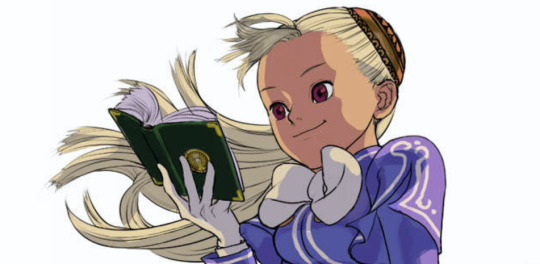
Ingrid is from a failed, unreleased CAPCOM game called CAPCOM Fighting All-Stars. Her first playable appearance is the ill-received crossover game CAPCOM Fighting Jam, known in Japan as CAPCOM Fighting Evolution.
In All-Stars, she was kind of a regular fighter, with a special importance to the plot and final boss. The very little we know about the plot hints on her being something beyond human. She carried a code Isis, is nicknamed the Eternal Goddess, and is said to posses the power of longevity.
On Fighting Jam, she has to solve some issues she had with Pyron, the final boss of that game and an alien who is basically a living sun and is hinted to be what ended the dinosaurs (i swear this is Darkstalkers Canon) Her ending there is... weird.
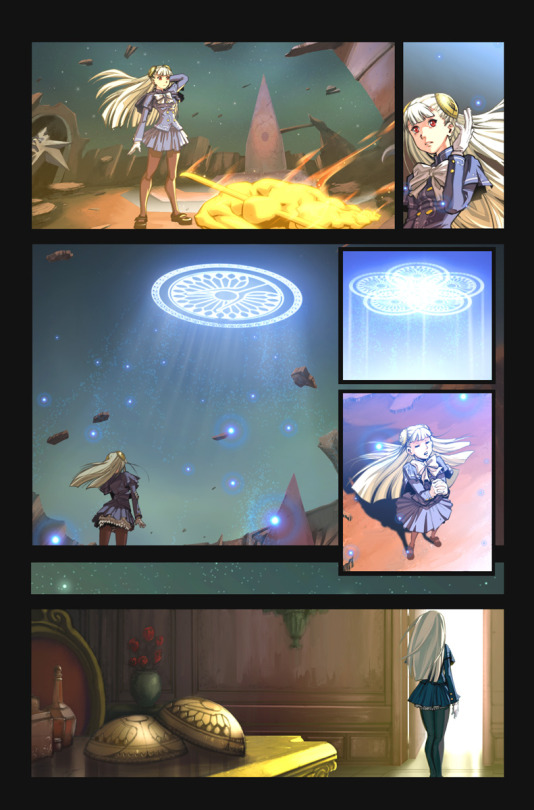
I brought this up because it adds a tiny little bit of context to her SFA3 MAX ending.
youtube
Ingrid claims ownership of the psycho power. Notice that its the power itself, not the Psycho Drive Bison's uses. And Bison is aware of that. Roses recognizes both as users of Psycho Power, even though she doesn't recognizes Ingrid. Also note at 00:59 that the focus point of the psycho drive carries Ingrid's Seal, the same one on the cups on her head AND the one she summons on her Fighting Jam ending. Oh, and she is capable of time travel. but no mention if she was the one who brought Yun to SFA3 time, though. What this all mean? Speculation time: According to Steven Mane's theory: With Ingrid being the creator of psycho power, Psycho power works better with women. You can even explain Bison's obsession with 16 year old girls: They are the ones who closely resemble Ingrid, who he knows is the original source of that power. This also explain why Bison's desire of a male body directly conflicts with psycho power: It was never meant for such body. and why there is so much female clones: It simply the result of experiments to see what fits better. But Bison is trying to get around this: He has been experimenting on both, noticing that male bodies deteriorate way faster, confirmed that female ones fit better, but for reasons only known to himself, this was not enough. The genderless Seth, a sentient machine build to gather psycho power, was Bison's latest attempt of circumvent the body type limitation, but it still didn't work (as stated by Bison himself) This is where Steven Mane's theory ends. But from that, we can jump to other conclusions: Ingrid is a goddess and is the source of Psycho Power energy. Notice that she is not the source of soul power though, so behind her innocent face, behind those red eyes, lies something sinister and evil. (Or maybe, Soul Power is simply Psycho Power with another name? Rose might be the one hiding something...) [Small June/2021 update: After a lazy Sunday re-reading the SF30th's bios, its is clear that Soul Power is not just Psycho Power with a different name. So if you want to follow this line of thought through, you have to consider that Ingrid is EVIL, or at least deals heavily with negative energies (closer to Akuma than Bison). and it opens the possibility of a God/Goddess of Soul Power somewhere out there on the SF Universe. but that is speculation for another time.]
Ingrid is time-travelling to specific points in time to collect parts of her power. Bison was one of those who stole it. Pyron probably did it too, and in 201X, Ryu has something to do with it.
Oh, extra fact: SFIII, the last game on the timeline, happens in 1999. SFV, the game that was released on the 10's, canonically happens during 1998. So the Ryu she is supposed to meet next is YET to appear (maybe in SF6?).
And because she is a time travellng goddess, not a dimension hopping one this means a direct connection between the worlds of Darkstalkers, Street Fighter and Red Earth, the three franchises from CAPCOM Fighting Jam: Darkstalkers' Human World could be considered to be Street Fighter's Earth, and Red Earth is literally another planet on the same universe, hinting a bigger CAPCOM shared timeline then we expected. We can also speculate that Bison ultimate goal would not be just global domination but to replace Ingrid as god/goddess of psycho power. And she took Yun to 1989 just for the LuLz. Why I didn't mentioned Ingrid up there in MY theory? because of CFN Portal. The Capcom Fighters Network Portal is essentially the final word on who is canon in Street Fighter. Released together with SFV, its a well documented, weirdly organized and deep source of any street fighter or final fight character you can imagine. Those 2 guys fighting on the intro of SF2 got bios there. As well as Hakan's daughters and Elena's Family. Heck, CFN Portal is the place that finally settled Chun-li's father name as Dorai.
There is also relevant guest characters and characters who appeared in other games but that CAPCOM consider part of the franchise and canon, such as Blade from the Street Fighter: The Movie game (now part of the North American operations of Shadaloo) and... Ruby Heart from MARVEL vs CAPCOM 2 (a version of her actually, before the events of that game). Ingrid is clearly shown as a guest character and NOT part of the street fighter franchise, as she does not have the SF franchise standard background. the only ones who this happen are special guests from, such as the ones from Street Fighter EX and Street Fighter 2010. Ingrid is also described there with her bio from CAPCOM Fighting All-Stars, rather then her own story on SFA3 MAX or even CAPCOM Fighting Jam, in a way making her role on SFA3 MAX similar to Evil Ryu's: A what-if non-canon scenario of the events of the game, that has no bearing on the main plot. Evil Ryu's ending are always Ryu kills everybody and wants more blood, never really explaining anything. Evil Ryu is more important as a visual representation of the dark side of Ryu rather than a character itself'. and because of that precedent, when CAPCOM itself gave her non-canon status, it's better to err on the side of caution and not consider her direct influence and acts when speculating about the plot and lore, unless they are the only source of some kind of hinted information. And there is one very canon character who has a situation like that. Killer Bee. As I mentioned before, the ONLY time Cammy acts as Killer Bee in canon is on her SFA3 arcade/story mode: In her intro against Rose, her very first fight, She initially starts under control of Bison. Rose actually recognizes Bison's Power and frees her, even before the fight starts. The fight itself is actually framed as a violent reaction to being freed. but there is a game where we can see Killer Bee Cammy in all her brainwashed glory: X-men vs Street Fighter. Released before Alpha 3 and the first game where Cammy is shown with her Alpha design. Her quotes there shows a profound reverence to Bison AND some are mechanical in nature. Goddess Ingrid (to differentiate a bit from Code Holder Ingrid) could be one of these instances: Canonically speaking, we know very little about Bison: What are his motivations, why he desires such levels of power or anything that would elevate him from one dimensional antagonist. Sagat started as that and became one of the most developed characters of the franchise. Gill is from the straight go good intentions that will end up bad. Seth is the whole reason of this essay, so I don't need to show you anymore how he turned out a interesting character. and there is G, who is either a suicide cult leader still looking for followers, or the savior of mankind. Not to mention that most players thought as a good guy until Rose's ending. like, holy psycho powered cow... Bison is still just the dictator who wants to rule the entire world. And the only character that deals with Psycho Power in a way that is not just evil power for the evil dictator is a character that, as far as CAPCOM is concerned, is not even acknowledged as the relevant version.
#street fighter#Street Fighter V#CAPCOM#Lore#M. Bison#Ed#Falke#Seth#Abel#Cammy#Decapre#Rose#Ingrid#Body Swapping#Street Fighter Alpha#Fan Theory
60 notes
·
View notes
Note
idk how to word this without making it super long, but i hope the reboot stays kind of trashy and soap opera-y like the original. one of the best things about the original gg imo is that it portrayed the wildly unattainable lifestyle of rich New York elites without making me think it could ever be realistic, you know? so i hope the reboot doesn’t try and tackle every social issue on the planet and ground it that hard in reality, because not only does it feel misplaced, it would also maybe cause people to view the original in that light and Gossip Girl is the last show that should be looked at as real life given all their... choice storylines.
i’ve had my general answer for this typed out in my drafts for a little while and it seems like a good day to post it since twitter is basically imploding over the news that the reboot won’t feature the slut shaming of its girl characters as the original did lol. i do have a lot of thoughts on this because it’s a complicated topic that i find so interesting, so this is about to be long, sorry dsbhjnkds.
i understand the feeling that a lot of younger tv these days is more interested in dealing with social problems than it is in producing high quality content (i’ve always felt the issue is much less that these shows are attempting social commentary and more that these attempts are often SO half-baked and often written by like 40 year olds who don’t really know how teens actually talk about these issues and most likely don’t fully understand these issues themselves or have anything worthwhile to say about them), and i understand the concern that it’s very much beside the point of gg, a show that once based a now-iconic ad campaign on the negative criticism it received on the basis of being inappropriate, to shy away from controversial subject matter.
but tbh i don’t think these two things (social commentary and entertainment) are necessarily mutually exclusive! i’m pretty positive it’ll still be relatively soapy, but i think they can do some dramatics while also dealing with the social issues that naturally come up better than they did in the original––sexual assault, slut shaming and lack of any racial awareness being the most glaring ones.
i’m sort of expecting something more like season 1 of the original. it wasn’t as intensely soapy as the later seasons were, but it was still dramatic and entertaining. and they did still deal with some pretty heavy issues, like eating disorders, suicide attempts, substance abuse, etc. i don’t think learning how to deal with these topics more responsibly will take away from the wildness at all. i actually think that the writers learning how to do this will make for much better, unique writing/storylines, i.e. less reliance on “that slut slept with my boyfriend” for drama (which was done to death in the 2000s anyway; we already have blairena so i don’t see why we’d need another version), more reliance on creative, original ways to stir up tension. the original show, frankly, could have been better in the later seasons if it focused less on the shock factor and quickly moving on to the next bit of drama, and more on staying in character and properly dealing with the issues its characters faced.
whenever anybody talks about the social unawareness of the original gg, fans jump right to “but it’s reflective of the time it was written in.” and it’s true: gg reflected and amplified its particular culture. this is a big reason why it was so popular at the time, and also a big reason why certain parts of it have aged pretty poorly. i’d say the new gg will not be any different in this respect. the original gg was written in a time when it was pretty normal to call a girl a slut; the new gg has been written in a time when most young people have decided, no it’s not okay to call girls sluts. the show will simply reflect that culture shift, as long as it’s done well. there are better, smarter ways to create drama in a show and i’m happy that the writers recognized that.
#the issue really isn't that they need to stay out of political issues#it's more that so many current writers throw these topics in willy-nilly without any understanding of them or care for their characters#it's the classic 'show don't tell' writing critique right?#a lot of current tv writers would rather have a character list off a bunch of twitter discourse talking points#than actually DEAL with these topics in any worthwhile way#like please just SHOW us how these issues work and SHOW us how they affect your characters#rather than giving us a bunch of brainless lines about smashing the patriarchy or whatever#if the reboot does this well––and i'm so interested to see if they do––i don't really think there's anything to worry about here#answered#anonymous#LONG POST#SORRY LMAO#reboot
17 notes
·
View notes
Text
controversial opinion time I guess but
hey gang? hey, gang. gang, hey. blaming your fans for them not reblogging your content enough (and saying that they’re Directly Responsible For Tumblr Dying) is an extremely passive aggressive, mean thing to do, and also completely ignores so many other reasons as to why engagement has changed on this site and posts don't circulate like they used to.
for one thing, whenever I see these posts, I rarely see the ops acknowledge the HUGE HIT to tumblr's userbase following the 2018 policy change/implementation of tumblr's terrible content filtering algorithm. tumblr lost roughly 1/3 of its engagement (https://mashable.com/article/tumblr-lost-a-third-of-its-users-after-porn-ban/) and countless content creators with it. some of them migrated to twitter and other sites, some of them seem to have straight-up vanished into thin air, and countless others lost their biggest or main userbase with barely any time to shift gears to something else. that's a huge, website-shaking change! but so often in these 'reblogs vs. likes' posts I don't see anyone acknowledging that and it makes me really upset!
you can't talk about the ways tumblr has undoubtedly changed these last few years and NOT address the nsfw ban! it's completely unfair to your fanbases to shift the blame of the biggest displacement of users the site has ever experienced on...the users who had no say in the policy change and reacted accordingly when the site started softbanning everyone, and filtering all sorts of tags from the search function (including important sfw ones, lest we forget The Entire Furry Fandom on tumblr discovering that basic-ass tags like #furry and #anthro were being blocked when the ban rolled around), and making uploading anything vaguely beige-colored a dice roll. tumblr still hasn't recovered from that, and unfortunately probably never will, not without some hail mary of policy changes and overhauls.
I've seen some pretty ageist shit regarding content engagement as well that tries to paint younger users as just Not Getting how tumblr functions vs. other social media sites like instagram and twitter, and on top of that just showcasing a really uncomfortable disconnect/animosity towards new users whose only crime is being younger than op and also more experienced with other social media platforms, it also is just. it's really unkind? it's super rude? how can you call your followers too clueless to know how reblogging works and then expect them to support your content via reblogging and not feel like you're insulting them until they give you the result you want?
moreover, lots of young/new tumblr users get the gist of tumblr's controls and get it very quickly! technology literacy is becoming more and more a part of everyday life for everyone, and if you really think that a teenager can't understand that reblogging puts a thing on their follower's dashboards, one of the main functionalities of the site (and also very similar to twitter, one of tumblr's main competitors), I really don't know what to say. sometimes people just straight-up don't want to reblog stuff to their blogs, and that's okay.
there's also a tendency to ignore the ways that blogging on tumblr has changed as its userbase has became more well-versed in its functions and, frankly, a portion of the userbase has grown up on this site. when I first started blogging on here, I was 17, I didn't use tags, I commented unrelated (and frankly sometimes really regrettably rude) replies directly onto artist's posts, and I basically just reblogged whatever I vaguely liked, and a lot of things I didn't totally get but thought Looked Cool/Funny so I reblogged anyways.
and that's fine, that's pretty par for the course of being young on the internet and doing whatever you want and having a good time (barring the rudeness, being respectful to people is the ideal), but as time went on my interests changed, my time spent online changed (I went from highschool to college to a full-time job that limits my time on social media), and I began engaging with tumblr's content differently. I made sideblogs for interests and content themes I didn't want on my main blog, I started liking stuff and then going back through my likes to reblog posts later, and generally speaking my number of posts a day dropped and I stopped being able to catch up on my dashboard every single day. and I'm sure my experience isn't unique for some other people on here.
a lot of the tumblr users I've known for a while just don't have the same level of intensity in fandoms like we did years back, not because of any malice or selfish, content-hogging intent, but because our priorities have changed. I definitely miss a lot of things about years past on tumblr when fandoms were booming and new Big Name Creators were cropping up all the time, and to be fair that's still happening on parts of the site if you know where to look! it's just different now. time has passed. people have changed!
that isn't to be defeatist and say that we can't show up for content we enjoy and reblog it, but instead that people can feel differently about stuff they used to adore, and be more particular about one thing or another they reblog, and straight-up miss stuff that they would have really liked but just didn't catch up on for a myriad of reasons. and that's also okay. engagement on tumblr is really, really tied up in personal preferences, and sometimes it feels like it does that more than most other social media sites. this is kind of the wild west of internet presences and everyone operates differently on here as a result.
and probably the most touchy point of all: no one is obligated to give you validation on the internet. no one. not even if they've read all of your fanfics you've worked really fucking hard on for forever and a day, or your comics that you've spent months, years, a lifetime researching and creating, or your beautifully, painstakingly timed and masked fan videos. they can absolutely consume any of these, and more, and they're still not obligated to reblog your work or promote you. it's not fair, yes, and it's completely understandable and super relatable to want recognition for the work you've done and the ways you've brightened other people's lives, but online most of your fans are still total strangers to you, and trying to control the behavior of total strangers because you’re owed their acknowledgement isn’t a healthy mindset to have.
and you can say that any fan of yours stops being a fan after they drop you for you lashing out at them for not unquestioningly giving you space on their blogs like you're owed, but being upset at being accused of bad behavior for what amounts to not wanting to reblog something this time around and changing your opinions based off of that is also a very understandable thing to do.
and that isn't because of any sort of innate cruelty, or pointed attack towards you. it's just because there is always a disconnect between the creator and the creation, and some people will never bridge that gap and engage with you more, or build a parasocial relationship with you, or seek out ways to support you. and plenty of others will do the exact opposite! it's a total dice roll because you're dealing with a lot more people than you realize scrolling past your content, and every person is different, and some of them don't fully understand how reblogs help a creator, and some of them do but just don't want that content on their feed, and none of them are inherently bad people for that.
I'm not saying creators have to be perfectly kind and civil and praise their fans all the time, but when you engage with your followers like it's a battle where you have to keep devising new ways to get them to share your content, it just comes across as super disingenuous, and people cop to that very fast.
it also, frankly, can make longtime fans who reblog your work regularly feel like their interest doesn't matter, and wasn't good enough, and that then it really is their fault that other people (other STRANGERS ON THE INTERNET) don't engage with your content the way you wanted them to. you don't owe them perfection, but that doesn't mean it isn't still an unkind thing to do.
so like. what can we do about this?
asking users to reblog your work is totally fine and can help! calls to action work more than nothing at all. it's possible to be respectful when asking people to reblog your work without also guilt-tripping them with "likes < reblogs" banners and passive aggressive tags/comments. generally speaking guilt is a really shitty motivational tool, and tends to breed more resentment than actual outcomes people want. like this post for example! I wouldn't have sat down and typed this all out if I didn't resent the hell out of being told I'm, personally, the reason tumblr is demonstrably not an ideal website for building a fanbase anymore. if I had that much power over this website I would have given the whole thing to the xkit team years ago and reveled in a functional website instead.
changing the way you post content might help! every site has its ideal posting days, times, and reasons for why some are ideal for one site and not another. doing a little research (https://sproutsocial.com/insights/best-times-to-post-on-social-media/) will yield some potentially helpful tips and tricks that might result in a post reaching more people. utilizing tumblr's search function is also important, and understanding the limits of the tag function (ie. only the first 5 tags of a post are used for tag searches) can help change one's habits to something a little more effective. this is why I tend to leave my tag babbling until after the main fandom/category tags on my posts, so that tumblr's jankass search has a better shot, haha
broadening your online presence can definitely help! this is by far the most terrifying option since it involves branching out onto other social media platforms, some of which really don't lend themselves to whatever fandom/content one produces, so like the other two above it's only a suggestion.
I keep coming back to twitter and instagram, but that's mainly because they're the two other powerhouses of social media right now, though admittedly they only really cater towards visual media (and mainly imagery, not longer video pieces), and they have their own weird quirks to learn and jank to deal with. but given how precarious tumblr's status has become in some ways, trying to build a presence on multiple sites means that you reach more people across the internet, and also means that if tumblr does yet another website-shattering policy change, your eggs aren't all in one basket.
of course these options aren't foolproof, and won't work for everyone in some cases or not at all for others, but my main point in all this is this: tumblr has irrevocably changed, its userbase has changed, and we are limited in the ways we can directly influence it, but there are still options. I'm by far not a social media expert, but then again none of the posts I've seen so far were made by social media experts either, so I honestly don't feel too bad for throwing my hat into the ring while we're all thrashing about in confusion
y'all aren't wrong that things have changed, but I'm begging you to have some compassion and to try not to turn the relationship between creators and consumers of content into a battleground, especially when a lot of the influences on these changes are things entirely outside of any of our's direct control.
also because it makes y'all sound exactly like this:

#long post#site engagement#a big long pissy rant because I am so goddamned tired y'all#especially because I can't escape these Hot Takes because none of them are tagged consistently#and new ones keep cropping up all the time#it's like whack-a-mole#every post I block sprouts another a few months later#tone doesn't carry through the internet very well but rest assured when I see shit like this#paired with people's screenshots of their like/reblog ratios#and it turning into a 'u think those notes are small check this out' party I get#really goddamned fed up with it#this is of course not comprehensive and mainly just me whingeing @ the whingeing but sometimes u just gotta
13 notes
·
View notes
Text
10 Times The Joker Almost Nailed Batman
https://ift.tt/2mWXDUm
We celebrate the craziest plans of the Clown Prince of Crime in honor of his first solo movie.
facebook
twitter
tumblr
He is the greatest villain of them all. He is the evil that tests Batman and makes the hero better. He is an uncontrollable force of chaos, more akin to a hurricane than a criminal, who strikes without warning. He believes that life is a chaotic farce and everything exists as part of a twisted game between him and Batman. He is the star of comics, television, cartoons, and film. He is the Joker, one of the most enduring symbols of evil in the last century.
The Joker is no match for Batman physically, so when he puts one over on the Dark Knight, when he “gets” him, it has to be a masterpiece of chaos and violence. These are just some of the greatest moments when the Joker put one over on his eternal adversary.
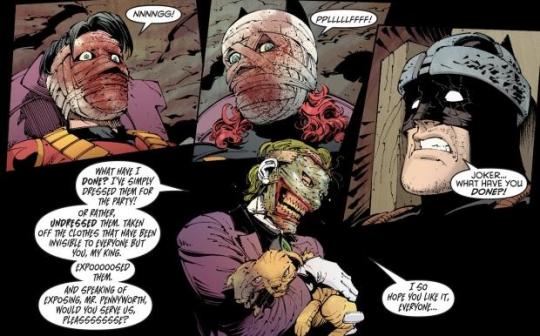
10. Death of the Family: The Dinner Scene
Almost Got Him moment: Made Batman believe he skinned his children. And he coulda done it too…
Scott Snyder and Greg Capullo gave us a Joker for a modern age. He embraced what went on before but really upped the ante in terms of intensity. Snyder’s Joker wore his own severed face as a mask and threatened the sanctity of such long standing but icons like Alfred and James Gordon. It all culminated in a dinner scene at the Batcave as a brainwashed Alfred seemingly serves each member of the Bat family, Batgirl, Nightwing, Red Robin, Red Hood, and Damian Wayne their own severed faces.
read more: The Many Deaths of the Joker
The pages read like a fevered nightmare as the Robins and Batgirl all sit starring at their own amputated visages. Staying true to his character, the whole thing was a joke, and the Bat family were unharmed, but their confidence in their mentor and their own safety was shaken forever because of the Joker’s actions.
Read Batman: Death of the Family on Amazon
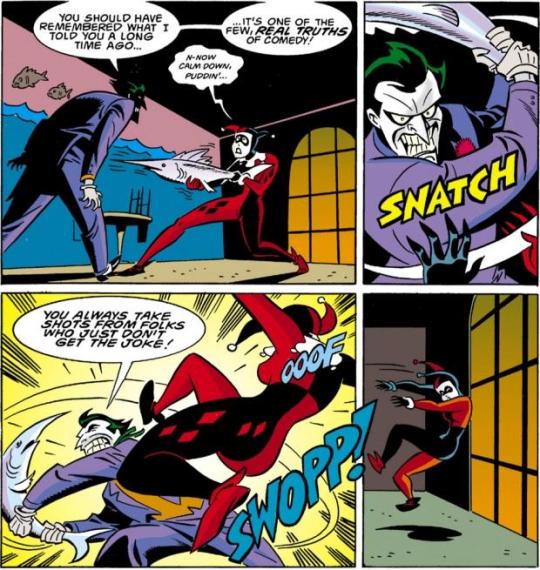
9. Mad Love (Batman: The Animated Series)
Almost Got Him moment: Harley beat Batman, and Joker created Harley. Although Mr. J didn’t quite see it that way.
The final episode of the New Batman Adventures is also its high point. The story deals with the origin of Joker’s moll, Harley Quinn, but it also serves as a reminder of just how all-encompassing the Joker’s twisted ability to manipulate anyone is. It was the first time fans learned that Harley Quinn used to be the Joker’s psychologist, and through sheer charismatic manipulation, he was able to mold her into his own twisted image. He made an educated woman, an expert of the inner workings of the psyche; believe that the world is a meaningless joke. Through the Joker, Harley had become a competent criminal, one who did what even he could not, successfully capture the Batman.
read more - The Best Batman: The Animated Series Episodes
In a moment that transcended traditional animation, the Joker shows just how depraved and selfish a soul he truly is by slapping Harley for making him feel inadequate because she defeated Batman and not him. The whole episode dealt with a broken woman’s devotion to the Joker, and her entire world came crashing down in one moment of shockingly realistic domestic violence.
Watch Batman: The Animated Series on Amazon Prime

8. Infinite Crisis “You Didn’t Let the Joker Play”
Almost Got Him Moment: Joker saves the multiverse, in a way that the Justice League couldn’t. Take that, bats!
Infinite Crisis was a huge, continuity laden epic all boiled down into the essence of a Superman, Batman, and Wonder Woman story. It was one of the biggest stories DC had ever attempted and it did shake the very foundation of the DC Universe, but with all the cosmic shenanigans, the story’s finale centered on one sick man, with no powers, forcing his will into the proceedings.
Alexander Luthor, the son of Lex Luthor of Earth-3, is the antagonist and the catalyst of the events of Infinite Crisis. His machinations are godlike as he manipulates multiverses like gears of a clock. Alex Luthor recruited some of Earth’s most dangerous villains to fight his battles against the heroes of the multiverse. Luthor dismissed the Joker as an unpowered wild card, a man who would be difficult to manipulate and useless in a fight against Supermen and Green Lanterns.
read more: Joker Movie Review
The Joker did not appear in any part of the epic, but is revealed by the prime reality’s Lex Luthor at the story’s climax. Joker sprays Alex with his signature acid flower and shoots him in the head, with a smirking Lex, who did not wish to share the villainous spotlight with the younger Luthor, declaring that Alex’s one mistake was he “didn’t let the Joker play.” This moment reveals that it could be a god, monster, or cosmic manipulator, whatever the case; the Joker is still more dangerous with a gag flower and a bullet. Sometimes the universe needs a master of chaos to do the things heroes can’t.

7. Batman 1966 TV Series: Cesar Romero's ‘Stache
Almost Got Him Moment: Every death trap, every gag, every cliffhanger. Shoulda taken those utility belts, Cesar.
Sure, the camp vibe from the 1960s Batman TV series set comics back a few decades. Even when Watchmen was being published, the public perception of super-heroes was still “BIFF POW WHAM!” Yet, for many young children of the '70s and '80s, the series was a gateway drug into the world of comics. While Romero camped up some truly ridiculous plots, there was something about his demeanor as the Joker that still strikes a chilling chord. That special way he had of frowning while wearing a painted on smirk, and the white face caked on over Romero’s signature ‘stache gave his Joker a sinister heir that transcended the shows limitations.
read more: The Actors Who Have Played the Joker
For many generations Romero’s performance defined the Clown Prince of Crime. Every time Romero appeared, he and his ‘stache would come within inches of taking out Batman and Robin turning his every appearance into an “almost got him.”
Watch Batman '66 on Amazon
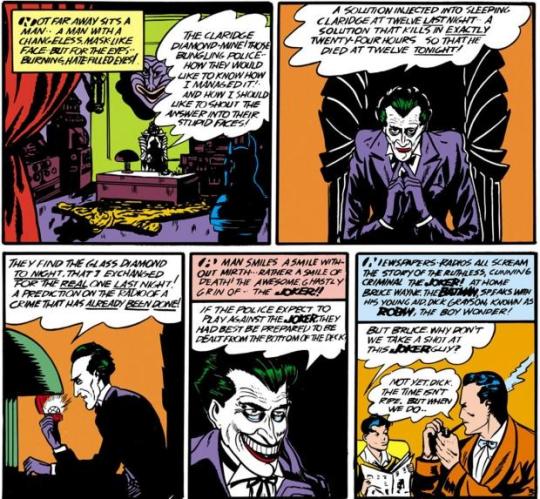
6. Batman #1: The First Appearance
Almost Got Him Moment: It all began here. Joker committed murder right under Batman’s nose until Batman figured out the eternal game.
Many times, especially in the Golden Age, a character’s first appearance only gives a readers a fraction of an indication of what the character would become. The Joker, being the Joker, defies expectations, and everything a fan needs to know about the character can be found in that first appearance in Batman #1. His use of poison gas, his terrifying penchant for popping up out of nowhere, his need to intellectually challenge Batman, all add up to relatively the same character that exists today.
read more: The Secrets of the Joker Movie
Based on actor Conrad Veidt in the silent film The Man Who Laughs, the Joker was a rarity for his day, as most villains were used to challenge the hero for one story and then fade away. Not the Joker, who endured, and despite some shifts away from the characters vile roots, he still exists almost identical to his 1940 appearance. This first story is so enduring that Chris Nolan adopted many elements for his first act in The Dark Knight including the unforgettable poison booze glass murder of Commissioner Loeb.
Even in his first appearance, committing crimes right under the Dark Knight’s nose, was a great moment of mastery over Batman.

5. Batman: No Man’s Land: The Murder of Sarah Essen Gordon
Almost Got Him Moment: In Gotham’s darkest hour, Joker managed to destroy the life of Batman’s best friend.
While Gotham was crippled and cut off from the rest of America’s infrastructure by a massive earthquake, the Joker strikes, kidnapping all the babies of Gotham. The Joker is confronted by James Gordon’s wife, Sarah Essen, and tosses her a helpless infant. When she catches the child, the Joker shoots her between the eyes.
read more: How Joaquin Phoenix Became the Joker
Many people treat the Joker as sort of an anti-hero, the freedom his manic behavior allows him is attractive to many fans, but this moment shows that the Joker is a brutal thug looking to take advantage of a tragedy to suit his own twisted machinations. The Joker took a delight in Gordon’s torment, promising even more pain in the future. The shooting of Sarah Essen, an honest cop and loving wife, stands as a constant reminder of the Joker’s cruelty. Batman’s inability to save his friend’s wife stands as one of Joker’s greatest victories.
Video of Bob Gun Batman 1989
4. Batman (1989) “Bob…Gun.”
Almost Got Him Moment: Batman robbed the Joker of his fun, but despite Batman’s careful planning, someone still died.
There are many fantastic moments created by Jack Nicholson in Tim Burton’s 1989 Batman movie. From his fantastic origin sequence in Axis Chemicals, to the murder of his boss, Carl Grissom (played by the great Jack Palance), to his climactic church battle with Batman, but his greatest moment, like all great Joker moments, was random and chaotic.
read more: Creating a New Joker Origin Story
At the beginning of the film’s third act, the Joker tries to poison Gotham with gas filled balloons, when Batman swoops down in the Batwing and drags the balloons away, the Joker is incredulous. Like a kid who had his favorite toy snatched by a playground bully, the Joker pouts and asks his most loyal henchmen Bob the Goon, for a gun. Bob, ever loyal to his boss, complies and the Joker, without changing expression, shoots Bob in the gut. Batman ruined the Joker’s fun, and someone had to die, even if it was someone loyal and useful to the Joker. Even though Batman seemingly saved Gotham, people still died, making Batman’s victory incomplete.
Watch Tim Burton's Batman on Amazon

3. A Death in the Family “The Crowbar”
Almost Got Him Moment: He killed Robin. Duh.
Yes, it was gimmicky to have fans call a 900 number and decide whether Jason Todd’s version of Robin would live or die. Yes, it robbed the story of any organic creatively, but even the most jaded reader has to admit the death itself remains shocking to this day.
Over the years, the Joker has used many gimmicked gags and traps to take down Batman and his family, but when it came to the moment where the Joker finally was able to kill a Bat Hero, he was just a thug wielding a blunt instrument. It was another reminder of just how dangerous and brutal the sometimes likable clown can be.
Out of Todd’s death, DC was able to ignite literally hundreds of story ideas from the arrival of Tim Drake, to Todd’s resurrection as the Red Hood. From one violent act with a crowbar, the Joker created a legend.
Read Batman: Death in the Family on Amazon

2. The Dark Knight “The Interrogation Scene”
Almost Got Him Moment: He did what no else could do, made Batman powerless.
One can fill a list of great Joker moments on Heath Ledger’s performance in The Dark Knight alone, but one stands out above the others. Yes, even above the pencil trick. After the Joker is captured, Batman and Gotham’s Finest believe that the ordeal is finally over, until the Joker turns his trump card, revealing that he kidnapped, not only Gotham’s beloved D.A. Harvey Dent, but Batman’s true love, Rachael Dawes, as well. There is one thing all the crooks and villains had in common in the Nolan Universe; they feared Batman.
Not the Joker.
At this moment in the interrogation room, fans and Batman realized that Batman had no power over the Joker. That the Joker did not care about pain, he couldn’t be intimidated, bribed, or threatened. The more violent Batman became, the funnier the Joker found the situation. This was a new type of villain, one who could not be controlled, a swarm of hungry locusts in a man’s form gleefully destroying everything in his path.
read more: The Dark Knight, the Joker, and Game Theory
As Batman races to save Rachel and Harvey, with just a few words (and a very well hidden cell phone bomb) the Joker is able to escape police custody. As Batman pounds on the Joker, it becomes clear just what an uncontrollable force the Joker is.
As Rachel burns, the Joker wins.
Watch The Dark Knight on Amazon
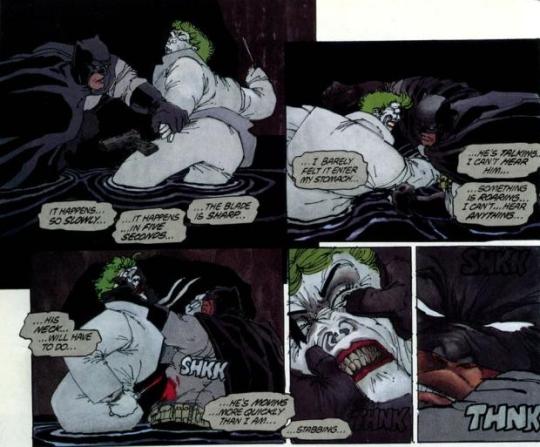
1. Dark Knight Returns ”The End”
Almost Got Him Moment: In his final moment, the Joker made Batman’s beloved Gotham see their hero as a murderer.
Nothing defines the relationship between Batman and the Joker, like the proposed final conflict. In Frank Miller, Klaus Janson, and Lynn Varley's The Dark Knight Returns, when Batman returns to Gotham after years of retirement, the Joker awakens from a coma to challenge the Dark Knight. Miller postulates, that without Batman, the Joker would cease to be, only returning when his other half was active. It was their final battle, and a battle in which Joker won. For decades, Batman refused to kill the Joker, but as the Joker snaps his own neck while laughing hysterically, it makes the world believe that one of Earth’s greatest heroes has finally turned murderer.
By destroying Batman as a symbol for justice and turning him into a symbol for selfish vengeance, the Joker turns the public, the government, and even Superman against Batman in the process. The Joker had won his greatest victory.
Read The Dark Knight Returns on Amazon
facebook
twitter
tumblr
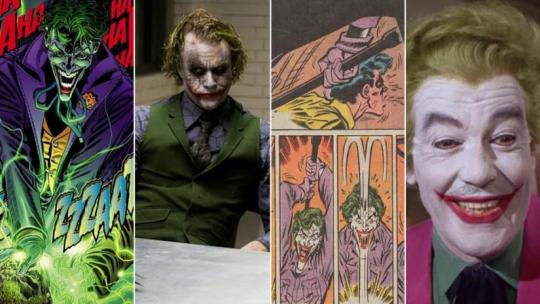
The Lists
TV
Movies
Marc Buxton
Sep 30, 2019
Joker
Batman
The Dark Knight
DC Entertainment
from Books https://ift.tt/2nVqs3m
3 notes
·
View notes
Text
The Weekend Warrior 12/11/20 - MINARI, THE MIDNIGHT SKY, LET THEM ALL TALK, WILD MOUNTAIN THYME, PARALLEL, WANDER DARKLY and More!
Honestly, I almost didn’t write a column this week for reasons I’ll probably be ranting about for a few more months, but the long and short of it is that I’ve now been writing movie reviews for 19 years, as well as writing a weekly column through most of that time, and I’m kind of sick of working my ass off, usually for very little money, and just not getting anything out of it.
This mainly came as I crossed 200 reviews for the year a few weeks back. As I was preparing to write this week’s column, Rotten Tomatoes, where most of my reviews have been available as FREE content for the past 17 years, decided to upgrade a number of critics to be “Top Critics”… but not yours truly. I have a lot more to say about this but don’t want to waste any more of my time or anger right now. I will be wrapping this column up and taking some time off for a month in January and deciding whether I want to keep wasting my time every week for no money and little feedback. It really just isn’t worth it anymore.
Fortunately, I saw a few good movies this week, and more than a few bad, so let’s start with one of the good ones, shall we?

This week’s “Featured Flick” is Lee Isaac Chung’s MINARI (A24), which like Nomadland last week will get some sort of virtual cinema release in New York and L.A., presumably that can be seen across the country. It will then get its official release on February 12, 2021.
The movie stars Steven Yeun from The Walking Dead as Jacob, a Korean father who brings his family to an Arkansas house in the middle of nowhere in the ‘80s, hoping to start a farm. His wife Monica (Yeri Han) is not happy with this decision but their kids Anne (Noel Cho) and David (Alan S. Kim) try to adjust to the new life. Things aren’t going well but then Monica’s mother Soonja (Yuh-jung Youn) shows up, that just adds more pressure on Jacob, and the kids, especially David, who hates the quirky older woman who acts nothing like a grandmother.
I’d been hearing about Minari going all the way back to its debut at Sundance, and though I remained skeptical, I finally saw it a few months ago an again over the weekend, and it’s one of my favorite films of the year, probably Top 5. To me, it’s somewhat in the vein of The Farewell, my number 1 movie of 2019, vs. the Oscar Best Picture winner, Parasite. It’s a very personal story for Chung who based some of the experiences on his own childhood, which once again proves the adage that if you’re going to write a movie, make it personal since that’s the most likely to connect with others. (Not always true, but it was great advice when I was given it.)
It takes a little time to understand why Minari is so beloved, since Chung takes an interesting approach where we see various scenes that don’t necessarily seem to tie into some sort of plot. Characters like Will Patton’s ultra-religious zealot who seems to be a bit lost when Jacob takes him on to help with his farm. Otherwise, we see various character interactions as things get tenser and tenser between Jacob and Monica, who are fighting all the time. Although the drama does get intense at times, there’s a lot of joyful and fun moments, particularly those involving the wacky grandmother and her dysfunctional relationship with her grandson. I also enjoyed the relationship between the two kids where Anne is always protective of her younger brother, who has some sort of heart illness.
It's a beautiful movie with an equally gorgeous score, but it’s really in the last 20 minutes or so when we start to see where Chung has been going with all these seemingly disparate elements, which builds up to a wonderful ending. Yeun is terrific, and the fact he reminded me of my own father -- we’re neither Korean nor have I ever been to Arkansas -- shows why his subdued performance is so effective. Overall, the film proves that however many awful things life might throw at you, your family can always fix things. I love that message, and I hope others will find and love this as well.
After its one week in virtual cinema, Minari will get an expanded theatrical release starting February 12… hopefully, New York City theaters will be open by then and I can see it in a theater.
Film at Lincoln Center in New York also is starting its 49th annual “New Directors/New Films” series, which was delayed from March, although being virtual, the movies in it can also be viewed nationwide for the first time. I feel like a lot of movies that were scheduled to play ND/NF ended up being released already but there should be some interesting things in there.

George Clooney’s latest film THE MIDNIGHT SKY is based on Lily Brooks-Dalton’s novel Good Morning, Midnight, in which he plays Augustine, a scientist dying on his own at the Barbeau Observatory in the Arctic, who has to warn a group of astronauts returning to earth that it’s no longer safe for them to return.
Clooney has made a lot of good and great movies over the years, so that I’m one of those people anxiously ≠waiting for him to make something great again after the disappointment of Suburbicon. Midnight Sky is definitely one step forward and a few steps back, as it’s impossible not to think of previous Clooney movies like Solaris and Gravity, as well as The Martian and Passengers and Ad Astra. Yes, we somehow have gotten to the point where every year there’s some sort of space movie, and while Midnight Sky at its best is better than Solaris or Ad Astra (sorry, but I was not a fan), there’s enough that’s so quizzical and confounding I’m not sure people will be able to follow what’s going on.
Much of the first half of the movie involves Clooney’s Augustine alone at the Artic base interacting with a little girl (Caoillin Springall) who is completely silent. If it’s ever explained what the girl represents, I must have missed it. There are also flashbacks to Augustine’s earlier career as a scientist and explorer played by a somewhat only semi-impressive Clooney kinda look-alike in Ethan Peck.
The best moments of the movie involve the crew of astronauts on the spaceship Ether, including Felicity Jones and David Oyelowo, who are in a relationship, Demián Bichir, Kyle Chandler and Tiffany Boone, as they deal with various issues. This is really where comparisons to Gravity and The Martian are earned, but that’s such a mighty quintet of actors that these sections are far more interesting than sullen bearded Clooney with his young ward. The production design and visual FX in these portions of the film are also quite impressive.
The Midnight Sky throws a lot at the viewer but then tries too hard to be quizzical and enigmatic about how all of it ties together until the very end. I feel that some of Clooney’s more mainstream fans will be quite confounded and possibly even disappointed. The Midnight Sky is Clooney taking a swing and only partially connecting, and it might require multiple viewings to feel like it’s a worthy addition to his filmography.
Either way, The Midnight Sky will open theatrically in select cities this week and then be on Netflix on December 23, just in time for depressing everyone on Christmas!
Also hitting Netflix streaming this week is Ryan Murphy’s musical THE PROM, which I reviewed last week. It’s great, I loved it, and can’t wait to watch it again!
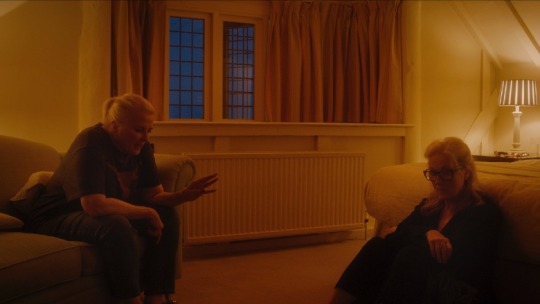
Next up is Clooney’s pal Steven Soderbergh, whose new movie LET THEM ALL TALK, will premiere on HBO Max this Thursday, December 10. It stars Meryl Streep as renowned writer Alice who is called to England to receive a prestigious literary award. Since she doesn’t fly, she’s booked on a cross-Atlantic trip on the Queen Mary II ship. Alice decides to bring her old friend Roberta (Candice Bergen)—whom hasn’t spoken to her in three decades--and Susan (Dianne Wiest) as well as her nephew Tyler (Lucas Hedges) to serve as her assistant so she can focus on her writing. Little does she know that her young agent Karen (Gemma Chan) is also on the ship hoping to find out what Alice is writing about with the help of Tyler, who is quite smitten with her.
I’m not sure where to begin with one of week’s films that I probably had the highest expectations and ended up leaving me with the most utter disappointment. I wasn’t really that crazy about last year’s The Laundromat, and I’ve generally found Soderbergh’s work to be hit or miss over the last few years. I loved his thriller Unsanefor instance, and the Magic Mike movies were fun. This one, written by author Deborah Eisenberg, is just plain boring for most of it, offering nothing particularly interesting or insightful, as it’s basically another movie where Streep is playing a character who moans about how difficult her life is and how much better everyone else has it. I mean, if I wanted that shit, I’d spend more time on Twitter than I already do. And then there’s Hedges, one of my favorite young actors over the past few years, who seems to have fallen into a niche playing
In fact, my favorite aspect of the film was Gemma Chan, who plays a character with far more depth and dimension than normal, although much of her role is just to spy on Alice and fend of the subtle advances by the much younger Tyler. The two actors have some fun scenes together, far more lively than anything involving the older actresses, but you always know where it’s going. It’s kind of awkward and painful to watch Hedges bomb so hard. (At least he fared better playing a similar role in French Exit, but in that one, his love interest was Danielle Macdonald.)
The movie looks good with Soderbergh handling his own camera duties and cinematography as usual, and it’s scored with the same hipster jazz he might have used in one of his Ocean movies, but the movie just goes on and on and on, and it hs one of the most “what the fuck?” moments you’ll see this year.
If you can imagine one of The Trip movies without any of the laughs or the delicious food porn…but on a ship, that’s basically what you end up with. More than once while watching Soderbergh’s movie, I was ready to abandon ship.

And from pretty bad, we go to much, MUCH worse. Do you know what thyme it is? It’s WILD MOUNTAIN THYME!!!
John Patrick Shanley adapts his own play Outside Mullingar into a film that will be released in theaters and On Demand by Bleeker Street this Friday, and believe me, its biggest problems isn’t some of the awful Irish accents on display, but they certainly don’t help. Emily Blunt plays Rosemary and Jamie Dornan is Anthony, childhood friends who live down the street from each other in their Irish farming community. When they grow up, Rosemary’s father dies leaving her with a plot of land that forces Anthony and his father Tony (Christopher Walken) to have to use a gate to get to their home. Remember this gate, because it’s going to be mentioned so much over the course of the movie, you’ll wonder why the movie wasn’t called “Wild Mountain Gate.” (It’s actually named after a song that Blunt’s character sings for no apparent reason.)
First, you’ll have to get past the odd choice of the very non-Irish Walken in a key role as the dead narrator of the story with that aforementioned horrid accent. It won’t take long for you to start scratching your head how a noted playwright like Shanley could write such a horrible screenplay. Soon after, you’ll wonder how he convinced someone to finance making it into a movie. I’m normally a pretty big fan of Blunt, but this movie and role might be one of her biggest missteps as an actor to date. As a child, Rosemary was told by her father that she was the White Swan in Swan Lake, so of course that will lead to
It’s not long before Jon Hamm shows up as one of Anthony’s distant relatives who also has interest in Rosemary’s plot of land – nudge, nudge, wink, wink. Pretty soon we’re thrust into awkward love triangle rom-com that falls somewhere between Leap Year and The Holiday. Not exactly something you’d expect from the filmmaker behind the drama Doubt that produced multiple Oscar nominations for the cast, eh?
Instead, Shanley ends up trying to foist the… I don’t want to call it chemistry. What is the exact opposite of chemistry? Between Blunt and Dorman with one long boring conversation after another. At one point, they’re having a romantic chat about suicide, the next Anthony is telling Rosemary that he thinks he’s a honeybee. I mean, what the holy fuck?
Honestly, the whole thing is just grueling to watch, because you wonder how so much talent could falter so badly, particularly Shanley? Even the recent Shane MacGowan doc was a far more romantic take on Irish farming than this could ever possibly be.
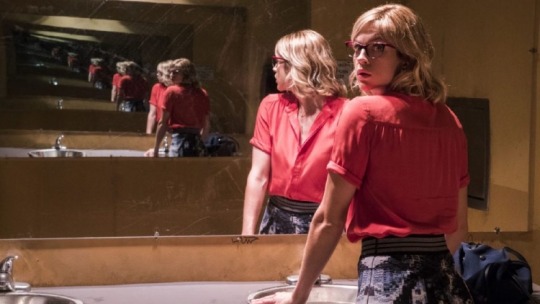
One of the nicer surprises of the week is the sci-fi thriller PARALLEL (Vertical), which will be in theaters and On Demand this Friday, and it’s likely to be missed by a lot of people who would enjoy it. Directed by Isaac Ezban from a screenplay by Scott Blaszak, it follows four young people working in the tech sector of Seattle who discover a mirror in a hidden section of the house they’re renting that apparently allows them to experience other dimensions and other versions of their lives. Soon, they’re experimenting with different ways they can make money and achieve fame, although not all of them are cool about how they’re doing it.
Although Parallel opens like a home invasion thriller featuring the great Kathleen Quinlan, we soon learn that it’s a red herring before we meet the quartet of young entepreneurs working on a parking app with an almost impossible deadline. When they find the mirror that leads into an alternative dimension, they immediately start to experiment with figuring out what is happening exactly, and once they do, they realize they can make money by stealing from “alts” i.e. other versions of themselves. Soon, their success starts driving them insane with a desire for even more money and power.
Ezban’s movie benefits from a talented mostly unknown cast, including Martin Wallstrom and Mark O’Brien as boisterous alpha males. Georgia King’s artist Leena is far more than a love interest, although she does become an obsession for one of them eventually – and man, does she remind me of a young Reese Witherspoon. British actor Aml Ameen plays Devin, whose father committed suicide after being accused of corruption, and he’s also wary of some of the activities his friends get up to. There’s also the quartet’s main competitor Seth who gets suspicious of their success as they start producing all sorts of incredible technical inventions.
Parallel is a pretty twisted sci-fi movie that in some way reminded me of the ‘90s thriller Flatliners and even Primer a little bit, but the mirror aspect to it also will draw comparisons to Oculus, one of Mike Flanagan’s cool earlier movies. It doesn’t take long for the twists to start flying at the viewer, and once they do, your mind will be boggled and not necessarily in a bad way. I wouldn’t want to even begin sharing some of the crazy places where the film goes, but even gore fans won’t be disappointed by some of it.
It’s a real shame this terrific movie has floundered without distribution or deserved attention for so long, because there’s absolutely no question in my mind that Jason Blum should be talking to Ezban and Blaszk about doing something together. Parallel is the type of quality high-concept thriller Blumhouse thrives upon.

Another nice surprise this week was Ekwa Msangi’s FAREWELL AMOR (IFC Films), which debuted at Sundance earlier this year and barely got any attention, which is a real shame. It’s expanded from her earlier short, and it’s about an Angolan immigrant named Walter (Ntare Guma Mbaho Mwine), who is reunited with his wife Esther (Zainab Jah) and daughter Sylvia (Jayme Lawson) after 17 years. As they share a small New York apartment, Walter and Esther try to rekindle their romance while Sylvia tries to adjust to an American school.
Msangi’s film opens at Newark airport where the small family is reunited, Walter not having seen either wife or daughter in a decade and a half. He’s working as a cab driver, and he’s ready to rekindle the old flame and meet his daughter who was only a baby when he moved to the States. (Little does Esther know that Walter was in a relationship with another woman, a nurse who isn’t too happy about having to leave Walter’s life.)
One of the things Msangi does to keep things interesting is that she splits the film into three sections, one for each character that focuses specifically on them, and the story gets infinitely interesting as we learn more about each of them. Walter is somewhat at odds with doing the right thing by his wife and daughter, who is wanting to explore her love of dance that her ultra-religious mother forebids. For some reason, I thought Sylvia’s section would be the most interesting as she deals with the trials of being a teenager, but then Esther’s section shows her to be a far more layered character we might have assumed earlier. She also befriends a neighbor woman played by Joie Lee that helps her expand. The thing is that all three are clearly good people, and you never feel as if one is doing something bad in relation to the others.
Farewell Amor is a quiet but beautiful film that explores an immigrant story in a far different way than we’ve seen before. It’s a discovery film, and I hope people will not just presume it won’t hold their interest. It’s a wonderfully relatable human story, similar to Tom McCarthy’s The Visitor.
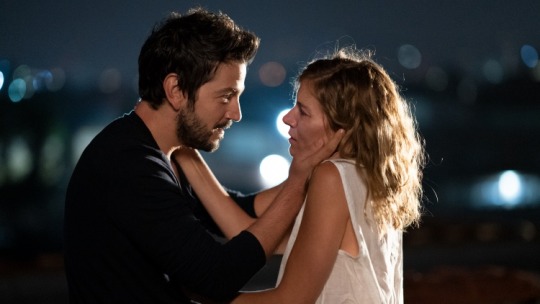
Sienna Miller and Diego Luna star in Tara Miele’s psychological drama WANDER DARKLY (Lionsgate), playing Adrienne and Matteo, a couple who recently had a baby. After they get into a horrible car accident while arguing, they end up revisiting the highs and lows of their relationship as Adrienne believes either she or Matteo or both are dead.
This is a surprisingly stranger film than I expected, delving into the supernatural not quite in the way as something like Wes Craven’s Serpent and the Rainbow or Jacob’s Ladder, but having a few elements in common. Although I haven’t seen Miele’s other films, this one feels very much like something Drake Doremus might have made to the point where I’m not sure I could say I fully understood what was happening from one moment to the next. The film seems to be exploring a couple’s relationship through a horrible tragedy but does in a strange way.
With the emotional performances by the two leads being enhanced by an amazing score by Alex Weston (who also scored The Farewell last year), Wander Darkly is more than anything, a performance piece with a decent script and further proof Miller continues to be one of the most underrated actresses working today. Despite those great performances, the movie’s strange premise might be too metaphysical and intense in execution for everyone to be along for the entire ride. In that sense, I probably liked last week’s Black Bear just slightly more.
I reviewed Steve McQueen’s ALEX WHEATLE (Amazon Prime Video) in last week’s column, and that will hit Amazon Prime this Friday, but I think I’m going to save Education, the last film in his “Small Axe Anthology” for next week’s column. I was also hoping to review Tom Moore and Ross Stewart’s WOLFWALKERS (Apple+) this week, since it premieres on Apple TV+ on Friday, but I just couldn’t get to it. Story of my life.
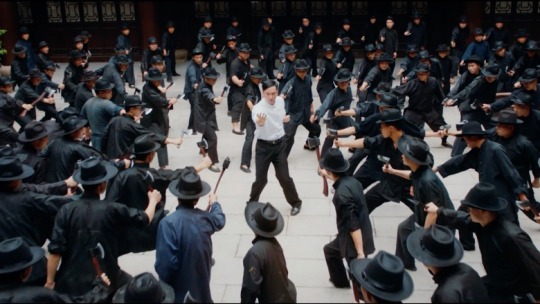
I’m not sure if I could tell you how many of the Ip Man movies I’ve seen over the past 12 or so years, many of which I saw at the New York Asian Film Festival, but Ip Man is indeed back after last year’s Ip Man: The Finale, but that’s because IP MAN: KUNG FU MASTER (Magnet/Magnolia Pictures) is part of the spin-off prologue series starring Dennis (Yu-Hang) To, who looked enough like a younger Donnie Yen to start a whole sub-franchise. This one is directed by Liming Li, who is also directing a Young Ip Man: Crisis Time prequel movie that presumably stars someone younger than both Yen and To. Got it?
Okay, maybe this needs a little more explaining, although the nice thing about Kung Fu Master is that it works perfectly fine as a stand-alone in case you’ve never seen any of the other movies. This one takes place in the ‘40s as Man is a police captain in Foshan, dealing with the ever-present gang known as The Axes. He’s framed for murder when the leader of the gang dies in prison, and his daughter, Miss Qingchuan (Wanliruo Xin), wanting revenge as she takes over the gang. Ip Man has other issues like being disgraced as a police officer and then the arrival of the Japanese army who have their own agenda. Ip Man ends up donning a mask to become the Black Knight to fight crime in another way.
I make no bones about my love of martial arts films when they’re not stupid or hoaky and sadly, the Donnie Yen franchise was getting by last year’s so-called “finale.” Kung Fu Master starts out with an amazing action scene of To fighting off what seems like hundred of axe-wielding gangsters, and it barely lets up, constantly throwing interesting and thoroughly entertaining fights at the viewer. Eventually, there’s a bounty on Ip Man’s head with whoever kills becoming leader of the Axes, but he has other issues, like his wife giving birth to their baby boy, just as the police chief and force shows up to arrest him. Cutting quickly between childbirth and kung fu action is just one of the interesting things Director Li does to make his Ip Man debut.
The resemblance between Dennis To and Donnie Yen is more than just facial as his wushu techniques are equally impressive, and sure, there’s a few more dramatic moments between Ip Man and his wife, but it’s Xin’s Miss Qingchuan who ends up being more of a formidable counter to To in just about every way, including a few fight scenes where axes are flying through the air.
Ip Man Kung Fu Master is fairly short, less than 90 minutes, but it still feels long because it feels like it finds a good ending, and then tacks on an epilogue and then another one. There were times I thought it might end on a cliffhanger to set up Ip Man’s inevitable next movie. The abundance of evil antagonists Ip Man must fight in this one tends to become a bit much, but it’s hard not to be thrilled by the martial arts on display and Li’s terrifically stylish visuals that keeps the movie interesting.
Ip Man Kung Fu Master will be available digitally Friday through a variety of platforms.
Filmmaker Adam Egypt Mortimer, who released Daniel Isn’t Real last year, returns with ARCHENEMY (RLJEfilms), starring Joe Manganiello as Max Fist, who claims to be a hero from another dimension that fell to earth. He ends up spending time with a teen brother and sister, Hamster (Skylan Brooks) and Indigo (Zelee Griggs) who want to clean the streets of the local drug syndicate, led by The Manager (Glenn Howerton from It’s Always Sunny in Philadelphia). It’s a strange and quirky dark superhero movie that includes appearances by the likes of Paul Scheer and Amy Seimetz, and though I ran out of time to review, I do have an interview with Mortimer at Below the Line.
Time to get to some docs, and there are definitely some you’ll want to check out, although I don’t have as much time to write that much about them, and some of them I wasn’t able to watch yet.
Another great doc out of the September festival circuit is Ryan White’s ASSASSINS (Greenwich Entertainment), which follows the assassination of Kim Jong-nam, half-brother to North Korean leader Kim Jon-un in 2017 at a busy airport in Malaysia by two young women. Although the two women had never met before, they were jointly charged with attacking the North Korean ex-pat with a lethal nerve gas called VX but White’s investigation takes him all over South-East Asia trying to get answers to how the two women were tricked into committing the assassination. This is a pretty masterful display of doc filmmaking by White, not just in the sense of the way the story is paced and edited like a good political thriller, but it’s one that keeps the viewer invested even as the last act deals with the trial of the two young women and the bond that forms between them.
I’ll have more about this film over on Below the Line sometime very soon, but it hits theaters and virtual cinema this Friday and then it will be on PVOD on January 15

I saw Seamus Murphy’s doc PJ HARVEY: A DOG CALLED MONEY way back in March when it was supposed to open at New York’s Film Forum, but it’s finally getting a virtual cinema release there. Murphy travelled across Afghanistan, Kosovo and Washington DC with singer/songwriter PJ Harvey as she prepared material for her 2015 album, The Hope Six Million Project, which she produced with Flood and John Parish as an installation at Somerset House where people can walk by and view the recording process. This is an amazing doc that allows you into the process of writing for an amazing recording artist who has given Murphy and the viewer unprecedented access into her creativity. I had fully lost track of Harvey over the years, even though I was a huge fan of hers when she first hit these shores – in fact, I saw her play a concert where Radiohead opened for her… and there as another band (Gallon Drunk) after them! Because of that, I wasn’t familiar with the album, but I just love good music docs, especially ones that take us behind the scenes of a talented artist, and Murphy has created quite a fascinating film even outside the recording studio, whether it’s following Harvey around (narrated by her own poetic observations) but also with commentary by others they encounter. I found the Washington DC segments particularly interesting, since that’s the one place where I’ve spent the most time. An absolutely fantastic doc whether you’re a fan of Harvey’s or not.
Also playing in the Film Forum’s Virtual Cinema this week is Thomas Balmés’ SING ME A SONG, the filmmaker’s second doc set in the Himalayan village of Bhutan that’s been isolated for centuries. He returns to update on Peyangki, the 8-year-old Buddhist monk from his 2014 film Happiness, now a teenager who has fallen under the sway of technology including pop music and smartphone games, as he begins a WeChat romance with a young singer, which makes him consider leaving the monastery.
Also premiering on Netflix this Friday is Jim Stern and Fernando Villena’s doc GIVING VOICE, tying into the streaming premiere of August Wilson’s Ma Rainey’s Black Bottom next week. It follows six student actors auditioning for the August Wilson Monologue Competition, which brings thousands of students from twelve U.S. cities together to perform the Pulitzer Prize winner’s work.
Joshua Faudem’s doc THE LAST SERMON (Gravitas Ventures/Will Kennan) follows the director and Jack Baxter as they follow 14 years after making their 2004 documentary Blues by the Beach, in which the two ended up in a terrorist attack by British Nationals on Mike’s Place, a bar next door to the National Embassy on Tel Aviv. This event sends Baxter and Faudem across Europe to refugee camps and mosques in order to understand the essence of Islam and the truth about the international terrorists that almost killed them.
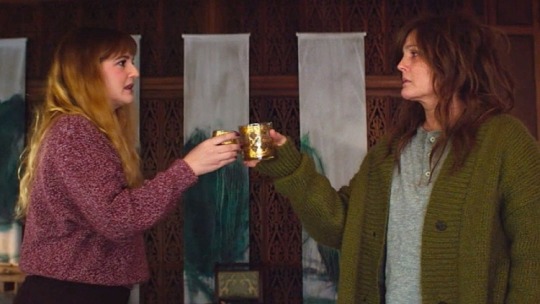
Drew Barrymore plays a dual role in THE STAND-IN (Saban Films), directed by Jamie Babbitt (But I’m a Cheerleader). While under normal circumstances, Wild Mountain Thyme would have been the dog of the week, then this movie came along. Yikes. Barrymore plays Candy Black, a comedy star best known for her pratfalls in bad movies (ala Melissa McCarthy). She also plays Paula, Candy’s much sweeter and almost identical stand-in. Candy is a nightmare to work with and after a fall from grace, she holes herself up in her Long Island Estate for five years, while Paula’s own fortunes falter without having that work. I’m sure you can figure out where it goes from there.
Yes, folks, we have what is now one of the worst iterations of a Tale of Two Cities not made by Barrymore’s frequent co-star Adam Sandler, although there are times where you wonder if she is actually playing a version of Sandler with Candy. Eventually, either Candy or Paula or both decide that Paula can take Candy’s place in her attempt to return to work, but the results are just far worse than The Hottie or the Nottie, as Paula also stands in for Candy on dates with the man she’s fallen in love with online through their love of woodworking. (I didn’t make that up.) You almost always know where it’s going and can’t help but groan when you’re right.
Basically, there’s one Drew that’s glammed-down and the other talking in an annoying wispy voice, so there really isn’t getting away from the awfulness even for a second.The thing is that, like the worst comedies, The Stand In is not funny, and it’s sad to see a decent director like Babbitt being dragged into this one. It’s just a terrible overused premise that’s executed quite poorly. Not only that, but the movie also co-stars TJ Miller, who has fallen so far from grace himself, that it’s shocking to see him in another movie.
Besides guaranteeing Barrymore a double-dose Razzie nomination, The Stand In also leaves her with cow shit on her face, much like her character.
Movies I just didn’t have time to get to this week:
Funny Boy (Array/Netflix) Gunda (NEON) Safety (Disney+) Bee Gees: How Can You Mend a Broken Heart (HBO Max) 40 Years a Prisoner (HBO Docs) Through the Night (Longshot Factory) To the Ends of the Earth (KimStim) Rompan Todo: The History of Rock in Latin America (Netflix) The Wilds (Prime Video) Nasrin (Virgil Films) Finding Ying Yin
By the way, if you read this week’s column and have bothered to read this far down, feel free to drop me some thoughts at Edward dot Douglas at Gmail dot Com or drop me a note or tweet on Twitter. I love hearing from readers … honest!
#TheWeekendWarrior#Movies#Reviews#Minari#TheMidnightSky#LetThemAllTalk#VOD#Streaming#WildMountainThyme#Parallel#TheStandIn#IpManKungFuMaster
0 notes
Text
Samurai Jack Season 5 in Review: EPISODE XCII
Here is my absolute favorite Samurai Jack episode, because it’s not the end. It’s only the beginning of the end.
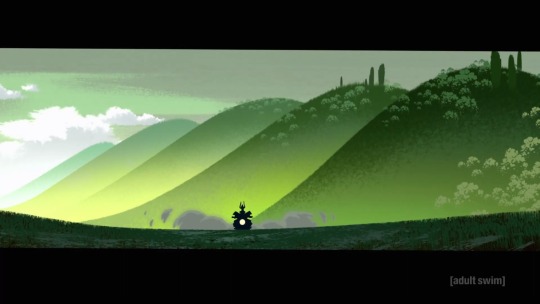
I was on the hype train for the return of @cartoonnetwork’s Samurai Jack after I saw the Season 5 trailer on February 8th, 2017 A.D. (I made a recent post to celebrate it) One reason was that I became obsessed about The Powerpuff Girls during the nostalgically incorrect Season 7 (the first “reboot” season) due to a liking for the Season 5-6 designs and animation, a part of the "Cartoon Cartoons” I grew up watching... and I was right to expect former PPG creatives on it! This post highlights the events of the episode and why it’s one of the best Samurai Jack episodes ever--and how much I binged on it at first! You can check the episode out here (Season 5 reran Sunday mornings at 3:30A on Adult Swim), and soon on HBO Max. Also, if you’re on Twitter, check the links to my tweets in the underlined text! They’re old tweets and need some love!
If you saw not this episode yet, be aware of SPOILERS!
/!\ SAMURAI JACK This Program is rated TV-14-V. Intense Violence.
X
The day of the season’s premiere, March 11th, 2017 A.D., too late found I that [as] was doing a streaming of Season 1-4 (I came in during EPISODE XXXIII’s “Wild Ride”). Following was a Q&A livestream with Genndy Tartakovsky, during which I tried again and again to call, but the line was always busy. Luckily Season 5′s premiere was going to be for free--online--via the stream at 10:40P! I was so there for it! Of course I watched the televised premiere on @adultswim, but the stream first!
While I began ceasing from trying to get Genndy on the PPGs again, all of a sudden...
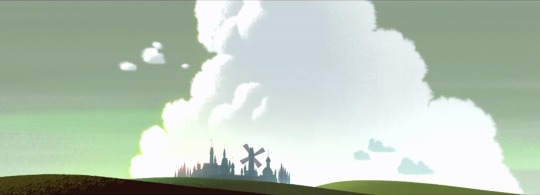
...it began, and I was totally there for it.
A view of a distant town (not Townsville) appeared. All quiet.

That is until an explosion or 2 set off (and not with the stereotypical H-B/Universal “powah-wahh” explosion sounds either). There goes the giant windmill.
Partially and slowly revealed is that some aliens are on the run from the town...
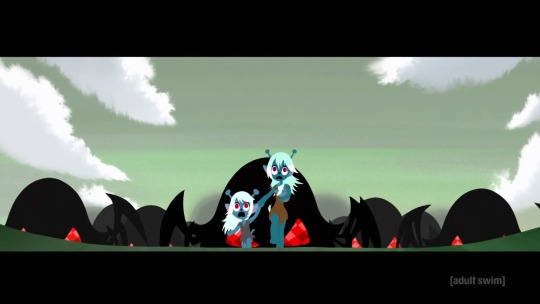
...from those “beetle bots”. GIANT beetle bots, I might add.

There is this precious little moment where, being surrounded by the giant beetle bots, the mother and daughter visually--not by speech--exchange “I love you!” to each other with hearts in place of “love”. Oh, and there’s a baby too.
As the beetle bots come to a stop, the sound grows quiet. A motorcycle is heard approaching. When the motorcycle is revealed close-up, Tyler Bates’ bass-filled music is sparked: a warrior with a serious, menacing face is riding on these hot wheels...

...and he aims his machine gun out... only to launch a projectile at these familiar foes...
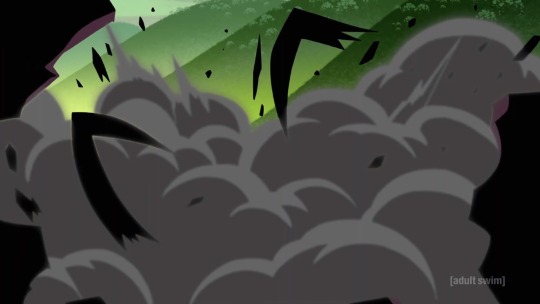
...resulting in the first explosion Jack caused in this glorious 5th season.
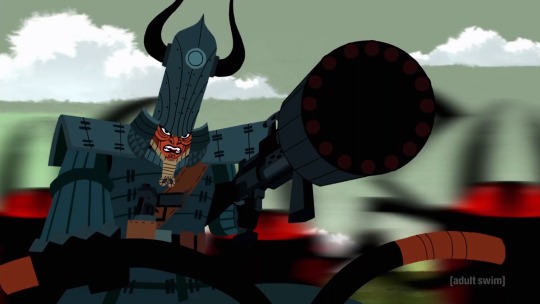
He slowly circles around with his gun. Is he a threat to the aliens?
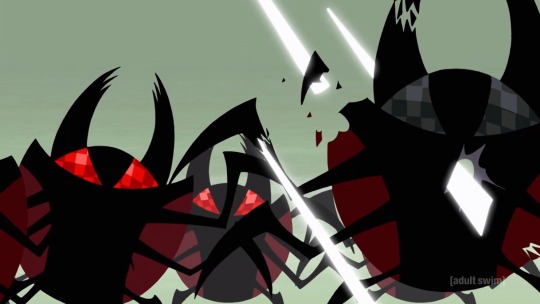
Nope. Just pwning more evil scrap metal.
Once I heard the Looney Tunes-esq “pshhh...” of smoke from his guns, I became more certain that Joel Valentine was back on the show... unlike the PPG “reboot”.
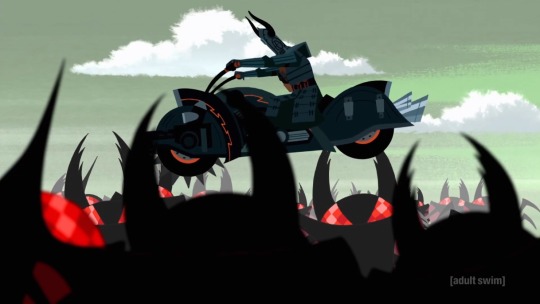
As the Season 5 sneak revealed late in February 2017 shows, the warrior’s motorcycle is packed with punk tires that can scrap these pests up! All of his guns are just as lethal... with all of those cool action shots and poses and all.

The warrior then reveals another weapon: not a sword, exactly, but some manner of pitchfork on one tip and a taser on the other. Graphically, he destroys one beetle bot by twisting the wires inside, and proceeds to scrap the rest until one of them knocks... the mask off?
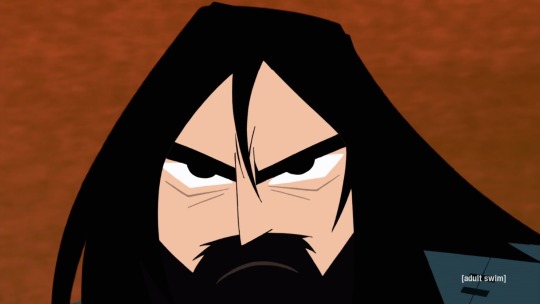
That warrior is none other than the samurai called...

“...?”

Just another day in the life of the samurai! Shouting a charging yell, Jack continues smashing the wires out of the beetle bots with a front scruff that fits perfectly with the mane... a look that is very appropriate, new and fitting for Jack.

The daughter gives a symbol of either “Is it dead?” or disgust. Because of the emoticons that are a major part of their visual language, I suppose that these aliens should be called... emoji-fawns?

“50 years have passed, but I do not age.”
As the samurai continues onward into the sunset, a new intro is revealed for Jack to explain how much worse things are become. The former intro started with Aku’s prologue before the theme song, but Season 5′s intro is pretty much a prologue. This feels true to the nature of of The Powerpuff Girls’ former intro which also started with a prologue, but PPG Season 7-9 has a shorter, different intro (although the extended version has an updated version of the prologue with most of its original Tom Kenny narration, “DJ Avalanche” score, and few of Joel’s SFX).
Regarding Jack’s opening statement, creator Genndy Tartakovsky said that 50 years were passed apparently between the events of EPISODE LII, “Jack and the Baby”, and EPISODE XCII. I think, however, that Jack meant that 50 year passed since he ended up in the future in EPISODE II, “The Samurai Called Jack”. There could be more seasons of this show to explore more adventures of Jack, regardless of the time that passed; if anything, turn those comic books into episodes!
Anyway, for some reason, the rip in time Aku created to send Jack into the future caused Jack’s body to supposedly not grow old, though I believe that, slowly, he still aged to a point. Aku’s still the bad guy (with a new voice, but I talk about this in XCIII’s post), and hope seems lost unless Jack can return to the past.

The intro ends with a slow reveal of the shows title, burning red in the dark, sporting an epic, exciting, modernly cinematic feel to the show. What follows, of course, is a scene just as cinematic...

A quiet, eerie chant of the name “Aku” subtly fills the dark, fire-lit room. This reveals the worship of a great evil which reminds us of how dangerous and powerful Aku truly is... given that “Jack vs. Aku” is the previous episode where Aku has a speaking role (you know... “EXTRA THICK!”), though he vocalizes in a following episode “Seasons of Death”.
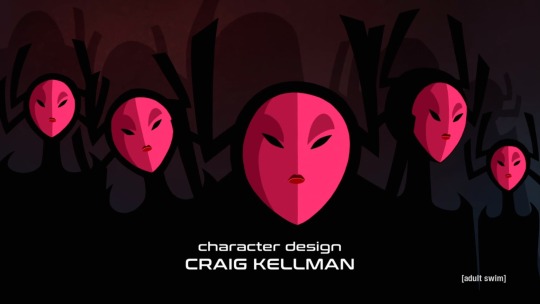
The episode’s opening credits reveal that Bryan Andrews and Genndy Tartakovsky are the main board artists for this season, still directed by Tartakovsky himself with art direction by Scott Wills. Apparently, character design was very crucial to this season, so the main character designer of the season, Craig Kellman, is listed at the beginning on all of these episodes. This’s rare for cartoon shows, but this isn’t much different from old CN shows of the 1990′s like Dexter’s Laboratory crediting the model/character designers on the episode’s opening credits.
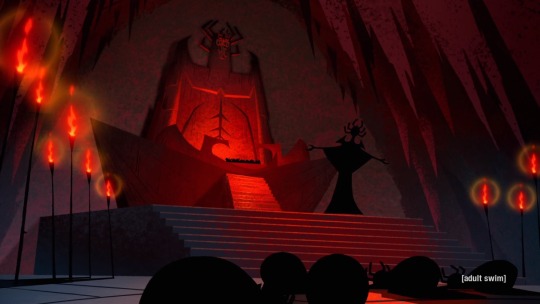
“They will succeed where so many others have failed, and we will find favor in your glory.”
Seven daughters?! Is that kind of physical labor even possible?! That explains all of Grey Delisle-Griffin’s screams, but she’s soon back on her feet... to raise her children to serve pure evil.
BTW, it’s a good thing that the baby vocals that Joel used are not the common Sound Ideas Series 6000 cries, since that recording is far more annoying. Anyway, I find the scene very intriguing and exciting because it’s all really dark, and that’s something that “kids” shows often weren’t in the past. It all just feels so epic that it sucks you in; am I right?
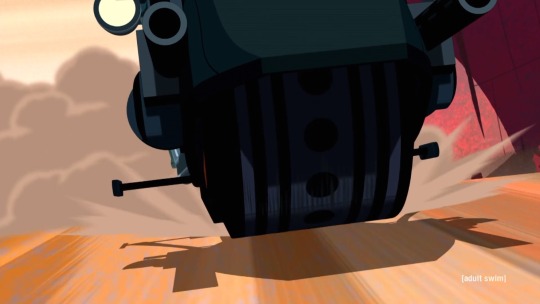
Back to Jack: the score revs up quickly in this montage of Jack riding around the country, wherever he is, as if he’s on some epic quest. Is he looking for a time portal or Aku’s place?

It’s Fall at this point and Jack’s in a pretty forest. The lighting is beautiful, cinematic and very realistic in this shot--one of my favorites from this episode. The paintings are still by art director Scott Wills; they’re just digital.
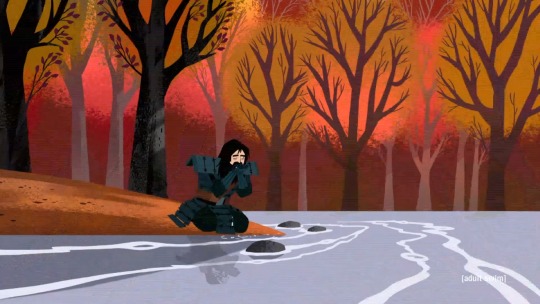
Such scenes as this are long periods of no dialogue, where music and sound can help to set the mood--sometimes, a very peaceful mood...
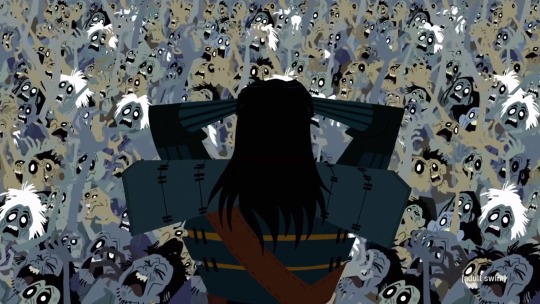
...until, slowly but surely, Jack’s mind is hauntingly messed up. This’s where Tyler Bates’ music hits on the slow, hardcore, eerie, electronic percussion that subtly drives the intense situation that’s not like what kid’s action shows used to be. This would be frightening to younger children, but the sheer terror of this scene is awesome, and the music is hardcore hot!
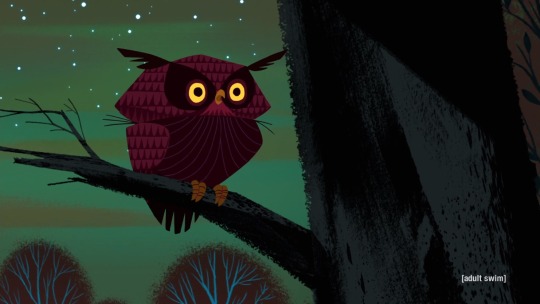
Some days later, we go to another sequence that occurs at night, where we focus first on a cute little owl hooting (and not the cliche, classic H-B/Valentino SFX Library owl hoot that many cartoons use, including past episodes of Samurai Jack). This goes to show just how realistic Joel’s sound design can be, and I admire him greatly for that attention to detail.
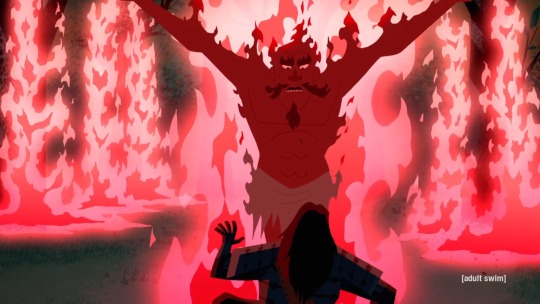
Jack endured another vision that night, where his father claims that he never came back, though Jack revealed that “Aku destroyed the way home!”
The way? How many time portals or such were there?

“He destroyed everything! Everything is burning!”
Woah. Was it something that Jack ate? It may be that that rat was under-cooked...
Anyway, every time Jack was haunted by the visions, a mysterious figure appeared afterward. Now Jack was motivated to find the village that he previously noticed was under attack. Time for a commercial break... and a breather for us fans of this nostalgic series!

As we return from commercial, we see the progression of the 7 daughters in training. They kind of remind me of Pokey Oaks Kindergarten’s students... but taller.
Training is tough on these little munchkins, though--but Ashi is distracted by a light that comes from the outdoors... to which her mother slowly objects. Her strength endures some real testing over time with her mother’s harsh treatment!
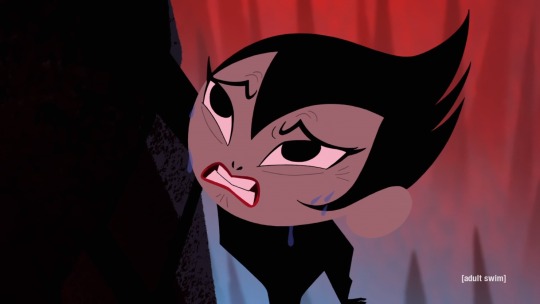
“Are you weak?!”
I mean... I felt like it was almost all over for Ashi at this point.

Luckily for her, “Aku’s fire stirs inside”. The art direction on the following scene is very interesting in terms of lighting: black, white and some red. It helps for the simply-detailed designs to stand out more. Since I saw very little of Sym-Bionic Titan at this point, Ashi’s hairstyle reminded me somewhat of Ilana (who has the same hairstyle and same voice actress, Tara Strong).
Meanwhile, Jack walked through the village to find whoever caused the destruction. He comes to a shady figure in the smoke, revealed to be a hot-shot assassin robot who goes by many names...

“Scaramouch the merciless! The Pied Piper of Ruination! The Crooner of Carnage! The Ambassador of Annihilation! The Eradicator of All, baby!”
The chipper, upbeat, overly positive attitude of “Aku’s most favorite assassin” made him instantly lovable. I loved this tin man from pretty much the very beginning. I immediately tweeted about this guy during the online premiere. I took a little while to know who voiced this guy (kind of sounded like Jimmy Gourd to me for some reason), but it was certainly familiar. Tom Kenny is the groovin’ voice of Scaramouche--another iconic voice from the man who narrated The Powerpuff Girls and voiced the Mayor of Townsville, Spongebob, Bon Bon the Birthday Clown and so many other great voices!
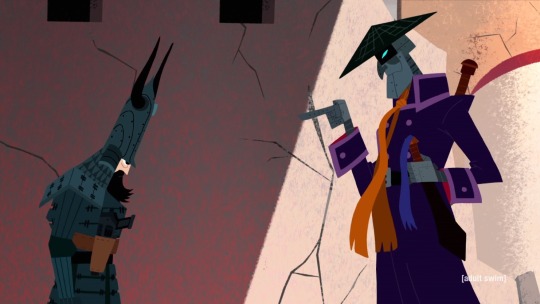
“Wait. Back off, beardsly. Where... is... your sword?”
You were probably wondering about that... so was I.

“You... lost... your sword!”
Well, the coloring on the handle of the sword is reversed in this shot, and it was just brown for the previous shot of the sword, but... yeah. Flashback to an episode that appeared not in Season 4. Destined to become an episode in the next season if CN makes any to explore the pre-Season 5 events.
Jack’s new pitchfork/taser thingy still makes the same “ching” sounds that his sword makes (and not the cliche Hollywood Edge recordings), though.
Anyway, Scaramouch was about to tell Aku the news (Aku apparently forgot about Scaramouch ‘cause he’s all like “Who is this?” First line since “Jack vs. Aku”!) when Jack and Scaramouch dance in a duel of musical magic.
“Ooh, nice choreography, baby!” Scaramouch replied. In a tweet I made of that line, I was thinking of cinematography instead and noted this to art director Scott Wills. I probably meant to note this to board artists Bryan Andrews & Genndy Tartakovsky.

Oh I just LOVE that “fffwwwhOOMP!” sound there on the ease-in. Joel Valentine packs the perfect punch into the sound of an object’s weight with those big whoosh sounds.
More important, perhaps: how can Scaramouch play the flute when he’s just a robot? He hasn’t any lungs or lips... that I know of... though he apparently has teeth and a tongue, and I can hear breath sounds during his lines... and his voice sounds not at all robotic!
Jack can really throw some real weight around as he battles against a monster made by music and of building parts...

“That samurai has gone beaucoup cuckoo!”
...but his haunting visions distract him from his heroic efforts...
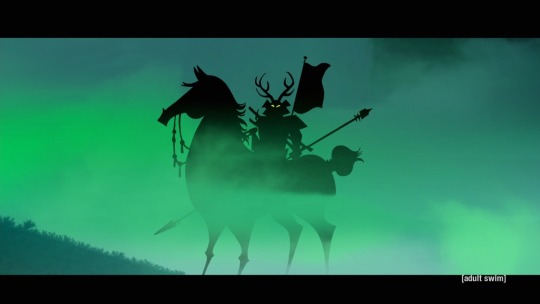
...once again seemingly attributed to that shadowy figure. This is a “CinemaScope” ratio for this shot, while the show is in standard widescreen (1.78:1 “matted”/”flat”). Those ratios can change a lot, kind of like IMAX (in movies in IMAX, one often sees certain shots of a 2.39:1 movie turning into 1.78:1 on a large screen, and the ratio goes back and forth). Still, ultimately the show is not in “letterbox” widescreen / “scope” format, like most Cartoon Network DVDs say; perhaps Warner Bros. Home Entertainment says this because Star Wars: The Clone Wars (the Dave Filoni series, only produced for Turner networks) was in 2.39:1; this caught on to some [as] shows like Genndy Tartakovsky’s Primal and Tigtone (the logos are 1.78:1, however), but most CN shows are just in 1.78:1.
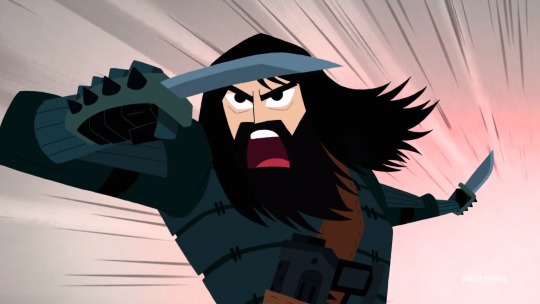
Anyway, knocked out of his mentally overwhelmed state, Jack was back into the fight, but, even though he sliced the flute in half, Scaramouch was the real “musical magic”. He just goes all “Scatman John” on Jack and can control wherever his sword goes, striking it right at Jack!

This is definitely one of my favorite shots from the episode... a slow-mo shot.
Jack seems to be fighting the sword itself until he comes closer to Scaramouch, who soon pulls another cold blade out...
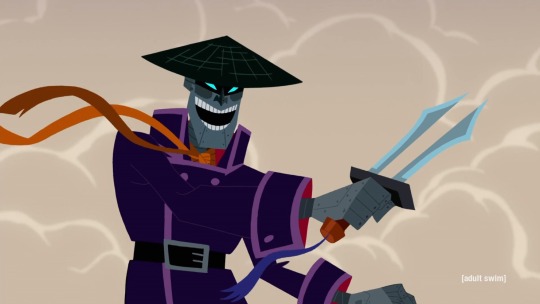
“Dig that beautiful sound, baby!”
...a split blade whose very tone of ring when clashed against an object can cause the clashed object to explode!

Luckily, Jack has good aim for his sword... so good, that it just blows Scaramouch away.

“Looks like you’re the headliner now; huh?”

Was...
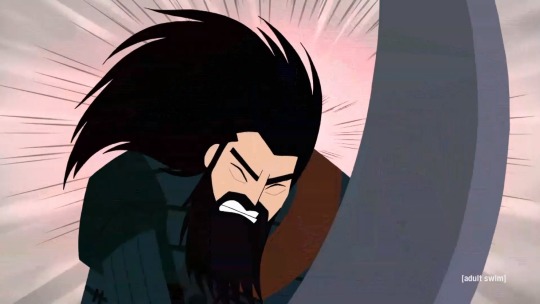
...is...

...and always will be.
Before the end of the episode, we see the last of the 7 daughters’ training. The music here just rocks. Its long, harsh percussion and bass-blowing beats really drive all of the action in this sequence.

This shot has great animation and angles, where Ashi shows an opponent who’s boss as she grabs the 3rd arrow shot and kills her with it.
For more sensitive viewers, first note that this and the following shot are violent/bloody enough to earn the episode its “TV-14-V” rating “for some intense violence” (I’d think that “TV-PG-V” might fit it, since it’s not as strong as it could be). However, CN aired some “TV-14-V” rated movies on their “Action Flicks” block back in early 2009 (i.e. Batman: Gotham Night). That’s right: CN, not [adult swim]! Since, like, 2007 or 2008, they aired a lot of TV-PG rated cartoons like Teletoon’s edgy Total Drama franchise, Regular Show, MAD, Teen Titans Go!, and even The Tom and Jerry Show (though that one seems overrated). I can understand why they often rated certain programs TV-PG-V: even a kick or punch could be a bad influence if a kid was prone to imitating action (The G-rated Garfield’s Pet Force strangely earned this rating too). The point is that CN needs to air Samurai Jack Season 5 on, even if some of the episodes are bloody (only few deserve the TV-14-V rating IMHO). They might be able to cut EPISODE XCII down to a TV-Y7-FV, perhaps.

It’s nice to see that Darrick Bachman from Paul Rudish’s Mickey Mouse still served on this lovely season. He’s the head writer for the 5th season... and the upcoming video game Samurai Jack: Battle Through Time.

As a devote fan of “Cartoon Cartoons”, I personally point the sheet timers out since CN’s traditionally animated shows have lesser animation these days, namely SMIP-animated shows. I mean, that Robert Alvarez and Randy Myers did the “Sheet Timing” on this episode of Samurai Jack (animated by Digital eMation) and animation direction on Seasons 7-9 of The Powerpuff Girls (the “reboot” episodes, animated by SMIP). Compare the action sequences of both shows, and the animation/timing will stand out; unlike Samurai Jack, the 2016-2019 PPG episodes (like SMIP’s work on Infinity Train & Ben 10) usually lack weight in their rather gentle, slow-paced animation. Those PPG episodes animate not at all like The Powerpuff Girls Movie or any PPG episode where Genndy Tartakovsky directed.

Here’re some of the new people on Genndy’s team for Season 5: Susy Campos, Andy Flexner, Jackie Sheng and Dick Grunert. Production Assistants (or, in this case, maybe production coordinators) can turn into major creatives for the story or art of the show, so watch for those names in future CN Studios projects! Team Cartoon Network Studios rules!

This season’s prop design is in the hands of @heydusty, who also contributed effects design and some character design / design clean-up. Dustin D’Arnault and others are new talent that live up to the work of Genndy Tartakovsky! The late and great Chris Reccardi returned, starting off with some prop designs as well. The design clean-up artists were also new to the team; these people clean the character, props and effects designs up after the respective designers did their designs, so they’re just as much designers as the designers listed. These “Clean Up” people are not to be confused for animation clean-up, however.
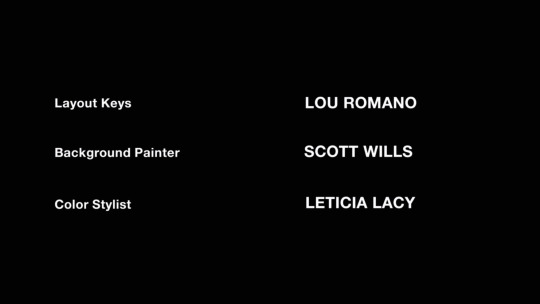
Next up are the background artists: “Layout Keys”/background designer Lou Romano (The Powerpuff Girls, Cats Don’t Dance, Ratatouille) and art director/Background Painter Scott Wills (The Ren & Stimpy Show, Quest for Camelot) bring the beautiful, colorful locations to life. Leticia Lacy, a former Spümcø member like Wills and Reccardi (and many other Cartoon Network Studios creatives), returned as a color stylist, who chooses the specific colors for the character, props and effects designed.

The voice credits are a bit lacking, since lesser characters are only listed as “ADDITIONAL VOICES”, compared to Seasons 1-4. This happened on Seasons 7-9 of The Powerpuff Girls too; i.e. Ms. Keane play supportive or minor roles in an episode, but Jennifer Hale is just credited as “ADDITIONAL VOICES”, though Keane is an important character to that series. Tara Strong is uncredited for voicing young Ashi since she only vocalizes--no lines. Greg Baldwin is in place of Mako as Mako passed away years before Season 5′s dialogue was recorded. Ultimately, though, Jack and his parents are still their respective voices, and it certainly is Phil LaMarr’s best.
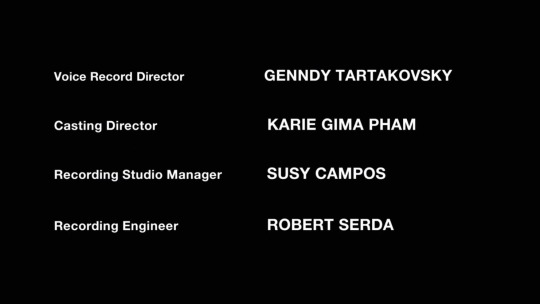
Unlike Seasons 1-4, Genndy Tartakovsky himself served as the voice director; previously Colette Sunderman handled the voice direction. Aku may no longer be voiced by Mako, but Genndy was able to direct Greg Baldwin’s “Aku” voice himself. Robert Serda still served for engineering the dialogue recording equipment at CN Studios.

The score composers score with their super awesome hardcore score. Tyler Bates composed music for Genndy’s Sym-Bionic Titan (I can’t believe that I never watched that show when it aired). Joanne Higginbottom co-composes with Tyler on Primal. Dieter Hartman also contributed score on Samurai Jack Season 5. For this episode, no score mixer is listed. Music Editors are uncredited in this season.
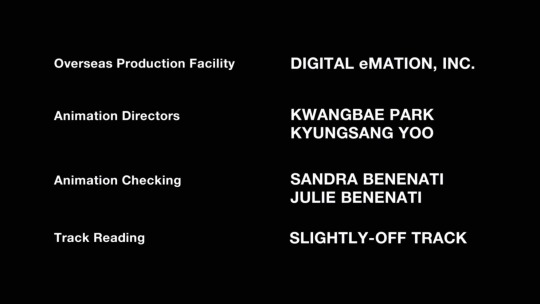
The animation company on most episodes of Season 5 is Digital eMation, which looks much smoother than the designs in the digital animation of Rough Draft Studios (lines looks slightly blobby on close-ups). The animation directors credited on the series are generally the overseas animation directors; in Season 5 they’re listed on the end credits since they relate to the animation studio.

Regarding post-production, I was very happy to see Joel Valentine credited for “Sound Editing” (He used to prefer being credited by the name of his company “TWENTY FIRST CENTURY ENTERTAINMENT, INC.” AKA 21st CENTURY SOUND DESIGN CORP.). I was afraid that it would be like Dexter’s Laboratory Seasons 3-4 (or 5-6) and The Powerpuff Girls Seasons 7-9, where mixing studio Hacienda Post/Sabre Media would do the sound design, but luckily Joel was on it. This time, former Supervising Re-Recording Mixer Timothy J. Borquez, CAS is just a Re-Recording Mixer with Alex Borquez (former Hacienda mixer Eric Freeman moved to mixing and editing sound at Disney Television Animation in 2014); both Tim & Alex were Supervising Sound Editors and mixers on PPG’s reboot era. Also credited for the final mix is Taylor Pierce, then a Mix Assistant. Currently, Genndy’s shows credit Hacienda Post’s facility, Sabre Media Studios, Inc., as the “Audio Mixing Facility”, rather than referring to Hacienda/Sabre as Post-Production Sound Services (Joel Valentine/21st Century Entertainment is just as much a sound service, NOT just editing!). I’m not sure if any other editors are involved at Sabre/Hacienda, but someone was recording and performing foley for this show, and, due to time, they get no credit, which is a crime in my opinion since that brings the show to aural life. Paul Douglas remains as the Supervising Editor and Jim Hearn as the Dialogue Editor for CN.

The Cartoon Network Studios logo for this season was visually simple, as it was just the face reveal scene show inside the logo (CN tends to use episode clips more often than animatics these days). Joel Valentine fit the sound effects to this well, though, with the sounds of a sword (not the ones Joel tends to use) and an anime-like accent. As for the “reboot” PPG episodes, they just did something weird... (couldn’t they show, like, the Hanna-Barbera swirling star inside the CN Studios logo instead?! at least for nostalgia?)

The Williams Street logo ([adult swim]’s production company), complete with the Mark VII jingle, follows since it was produced for that often junky block of CN...
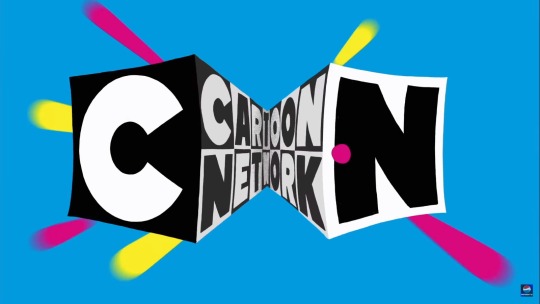
...but, on the digital copy prints, the 2016 Cartoon Network ID follows! Nostalgically, though, I prefer the 1999 “Cartoon Cartoons” ripple ID, which Samurai Jack and even PPG Seasons 7-8 used to show. I mind the 2016 ID on the PPG “reboot” episodes, but I mind it not on Samurai Jack because it proves that, while considered “Adult Swim”, the amazing Season 5 still remains a part of the “new new new new” era of Cartoon Network.
Any viewer of Samurai Jack could start with this episode as Jack’s adventures are just beetle bots here and Scaramouch there, occurring over few days. The other side of the episode, the youth of Ashi, occurs over probably years; this only sets the main events of Season 5 into action with the next episode.
As for me, I did all that I could with the streaming marathon of EPISODE XCII. It went on from, like, 10:48P or something until, like, 7:30A that morning. I couldn’t help but observe the episode again and again and again... I binged on it. I update the credits on IMDb. I tweet much about this episode and its team. By the end of over 8 hours of the episode’s stream, I felt that this was an appropriate response:

Before the end of this post, here’re reasons why EPISODE XCII is one of the best Samurai Jack episodes ever:
This “Cartoon Cartoon” returned after 12 years, 14 months and 5 days. According to Genndy’s forward on the Season 4 DVD, “The big question as we neared the end of production was, ‘Should we end the story and send Jack home?’ At the time, I felt that the proper way to end it would be to do a full-length movie - and still do. Hopefully, that movie is somewhere in the near future...” CN Asia-Pacific did this “Sayonara Samurai Jack” marathon for Season 4, but they were hasty, since the return came a dozen of years later, and Season 4 wasn’t the true end of the story. I feel the same about Disney Channel calling Star vs. the Forces of Evil Season 4′s finale “Cleaved!” the “series finale”, and both Daron Nefcy and fans look forward to more episodes in the future.
The nostalgic design and animation of Genndy’s Cartoon Network Studios team was something that the then-current Powerpuff Girls episodes were certainly lacking.
The action is just as intense and detailed as ever, with the right amount and style of music too. Perhaps even more wicked than before, though I miss “DJ Avalanche” James L. Venable, who wasn’t on it because he was busy with Clarence. Paul Rudish wasn’t on this season either, probably due to his hilarious vision of Mickey Mouse of course. Still, the stakes are high and handled well.
The precious moments of our little emoji-fawn family and the haunting fears of Samurai Jack are draaamaaa
The wonderful Scaramouch is our comic relief for the episode. Thanks, Tom Kenny!
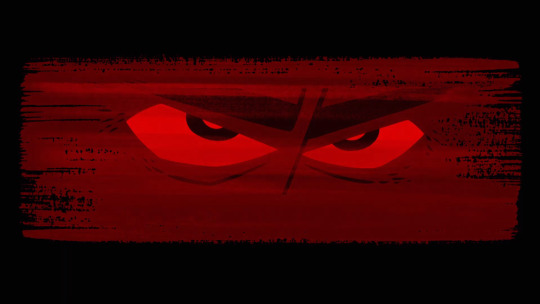
“WATCH OUT!” There’s that classic closing to most of the episodes, just like we remembered it. The credits look just as simple as they looked before, too.
Next Episode’s Review
Tweet version here.
Tweet version as a shoutout to Tom Kenny & Greg Baldwin here.
#samurai jack#samurai jack season 5#episode xcii#genndy tartakovsky#cartoon network#2017#march 2017#cartoon network studios#hanna-barbera cartoons#hanna barbera cartoons#bryan andrews#craig kellman#joel valentine#nostalgia#nostalgic#lou romano#scott wills#dustin d'arnault#chris reccardi#christopher reccardi#robert alvarez#randy myers#scaramouch#scaramouche#adult swim#[as]#[adult swim]
1 note
·
View note